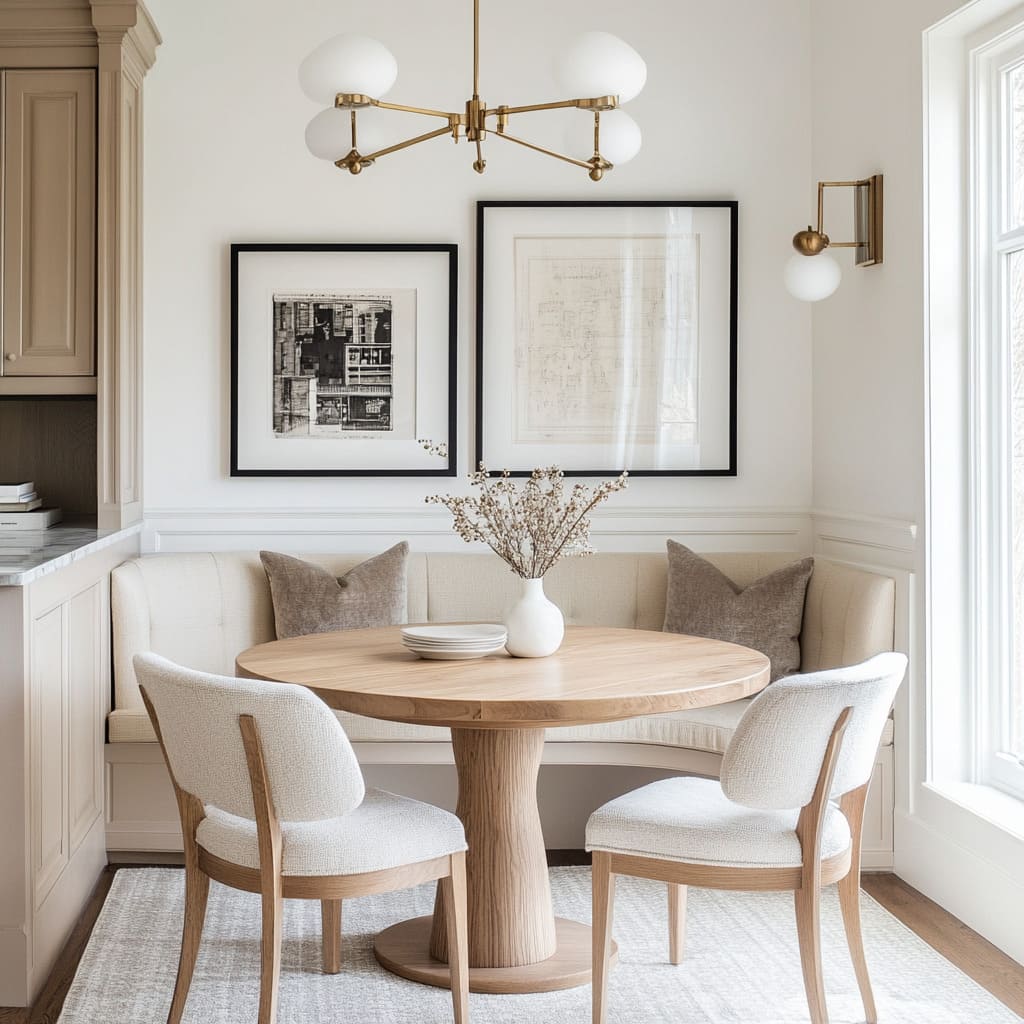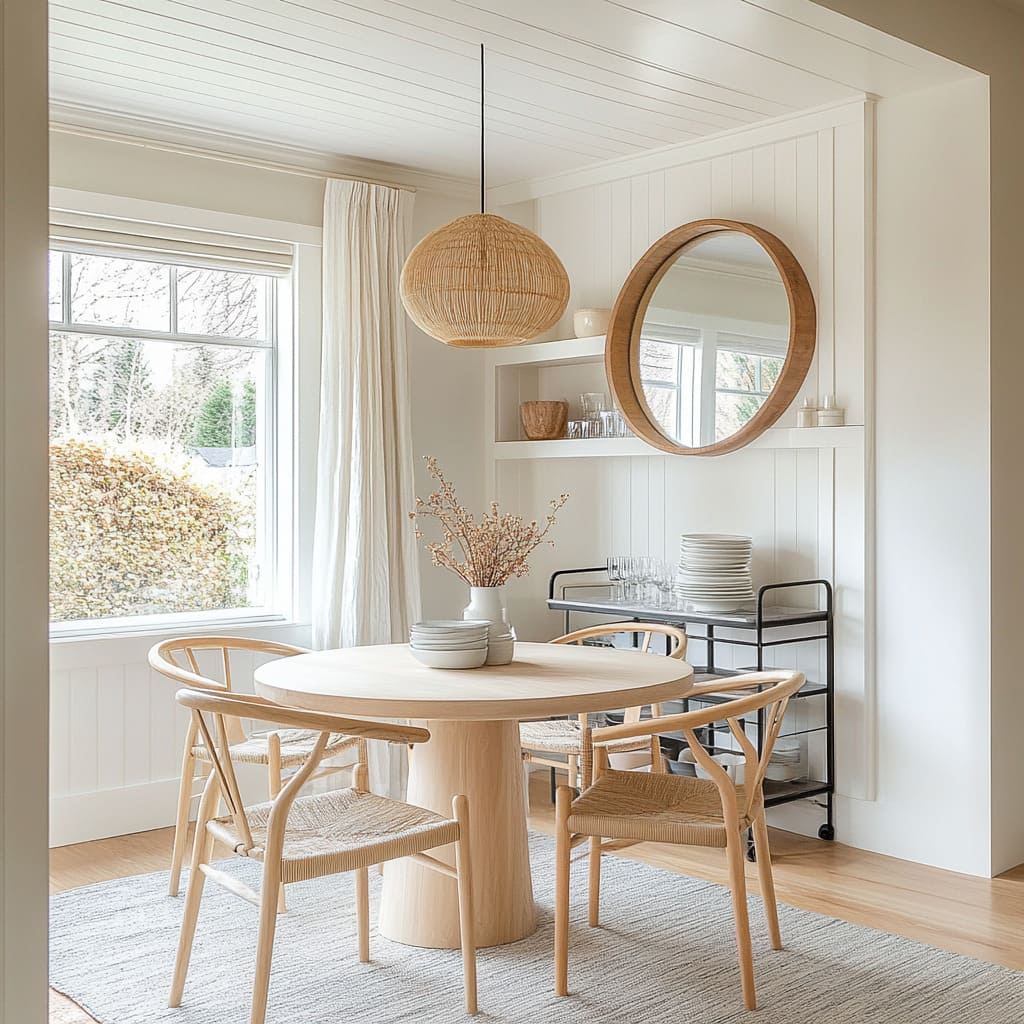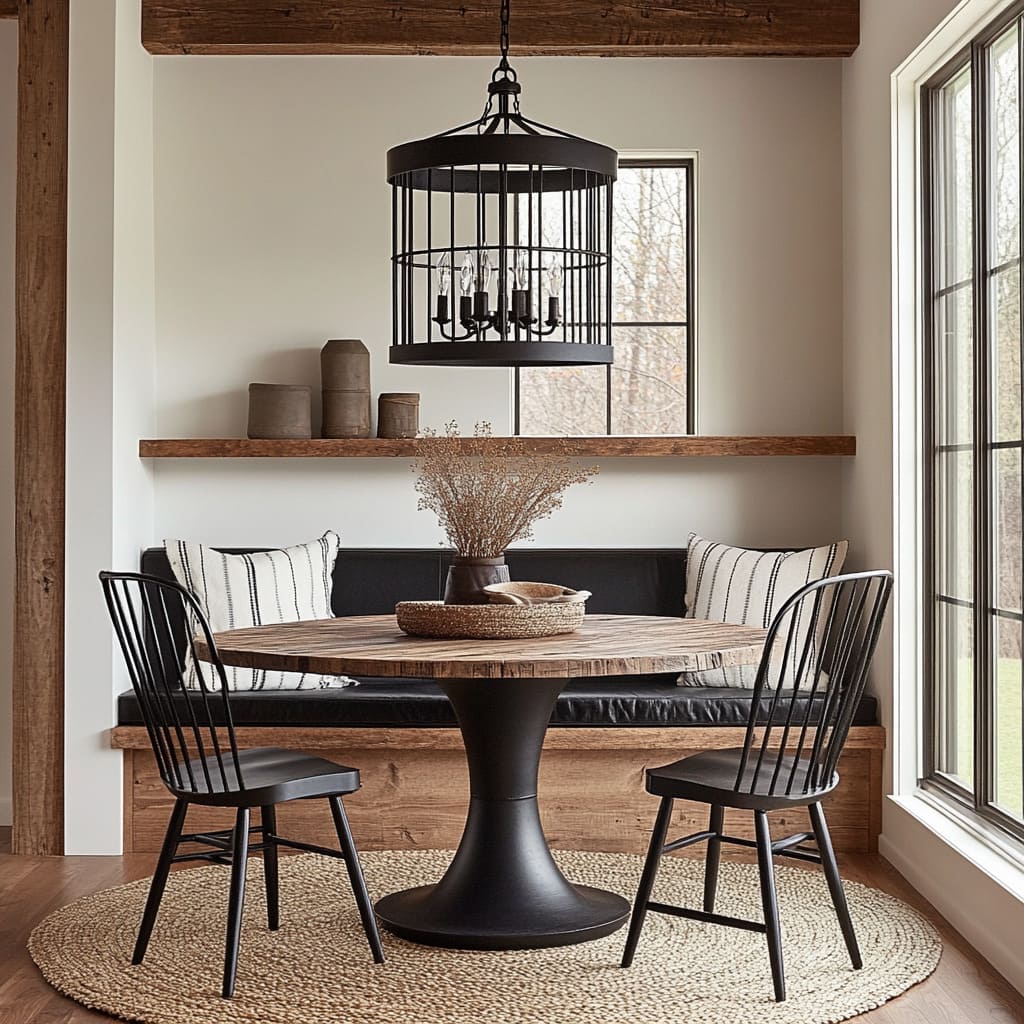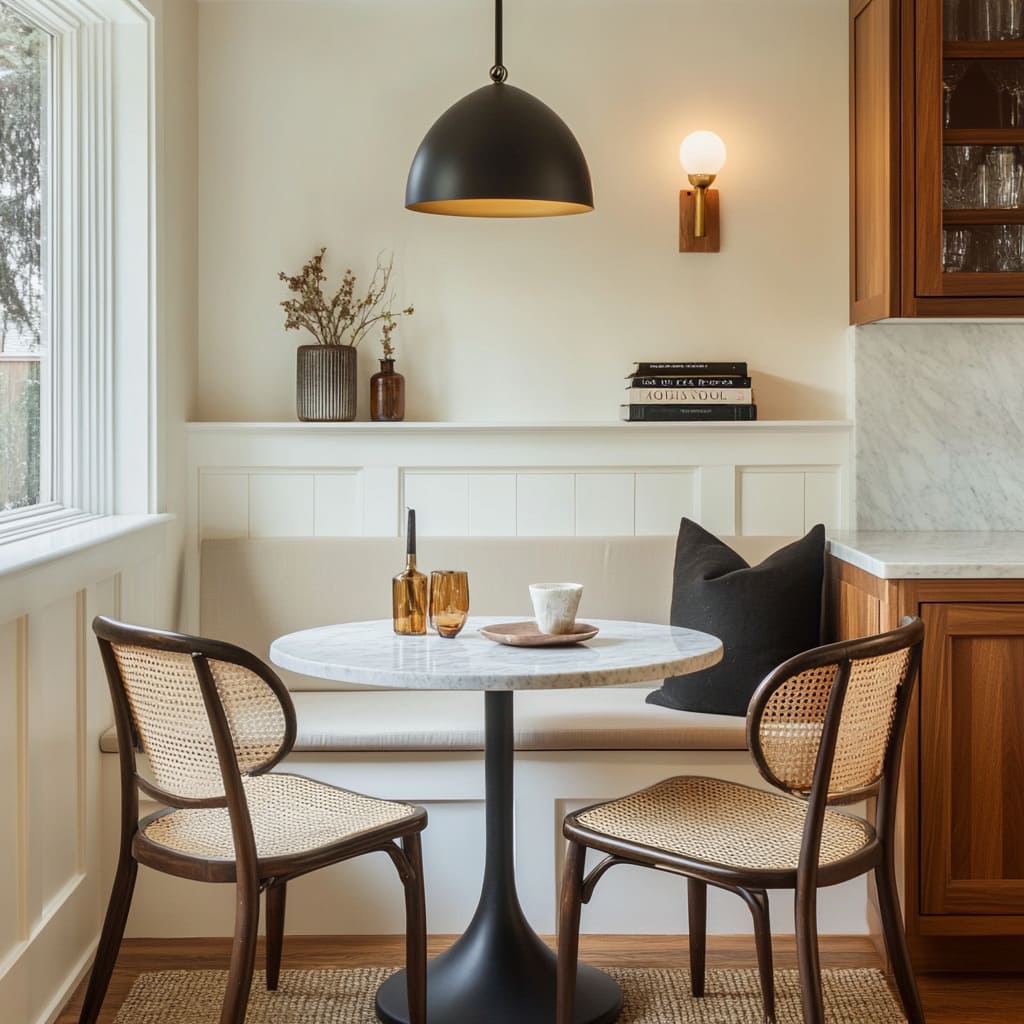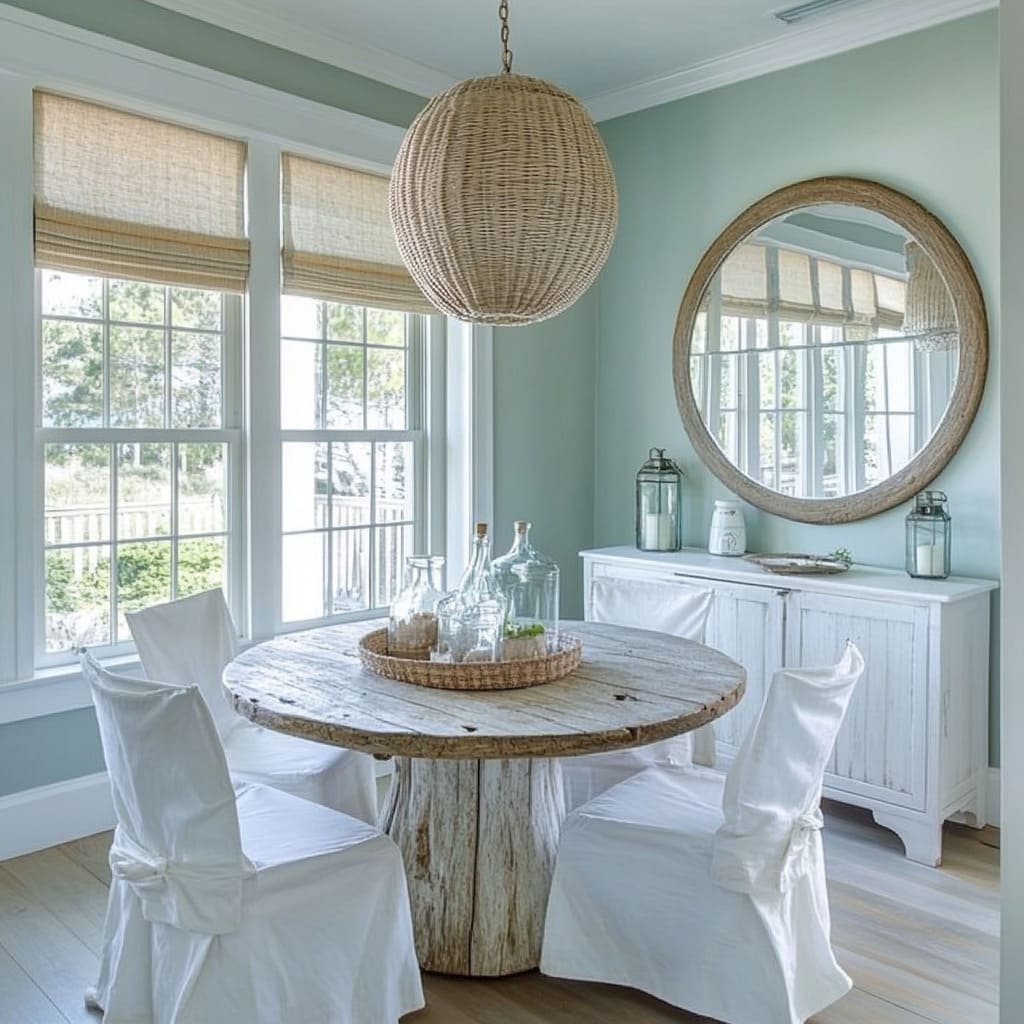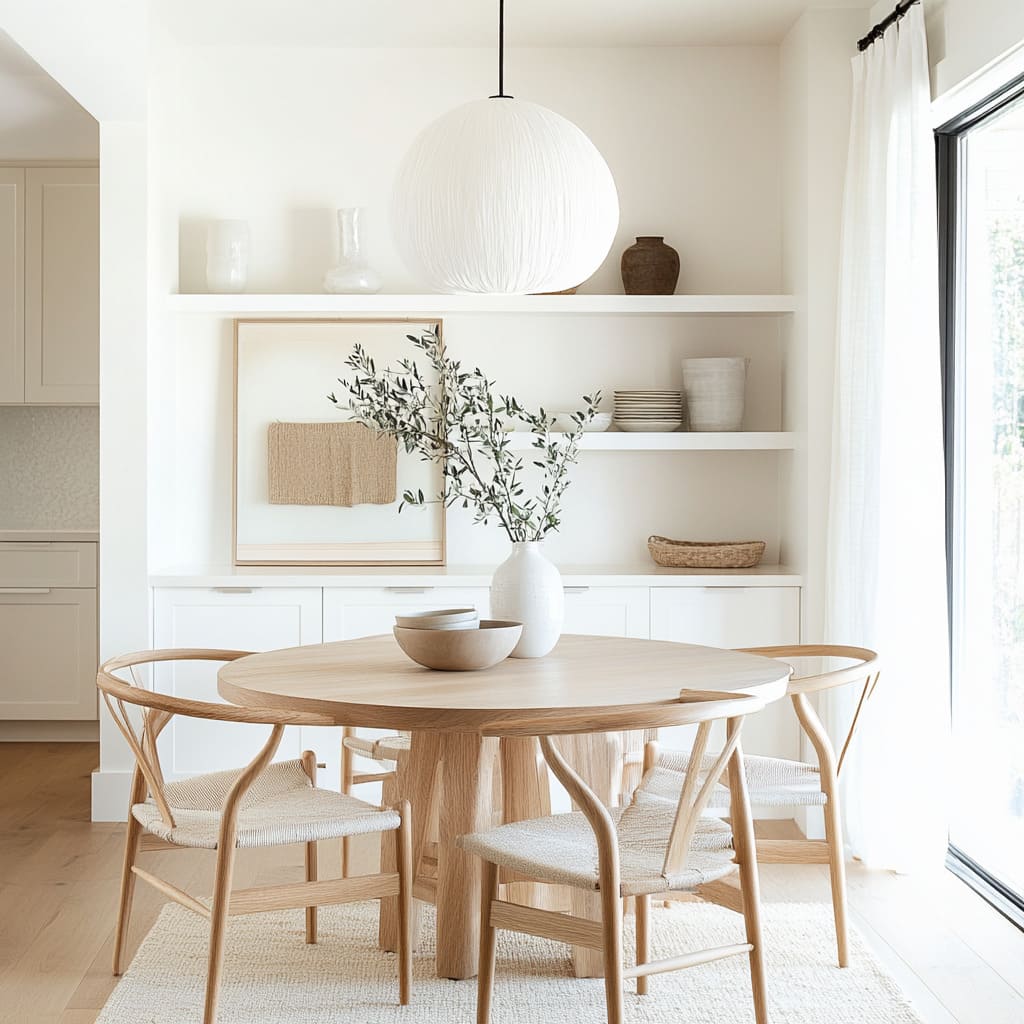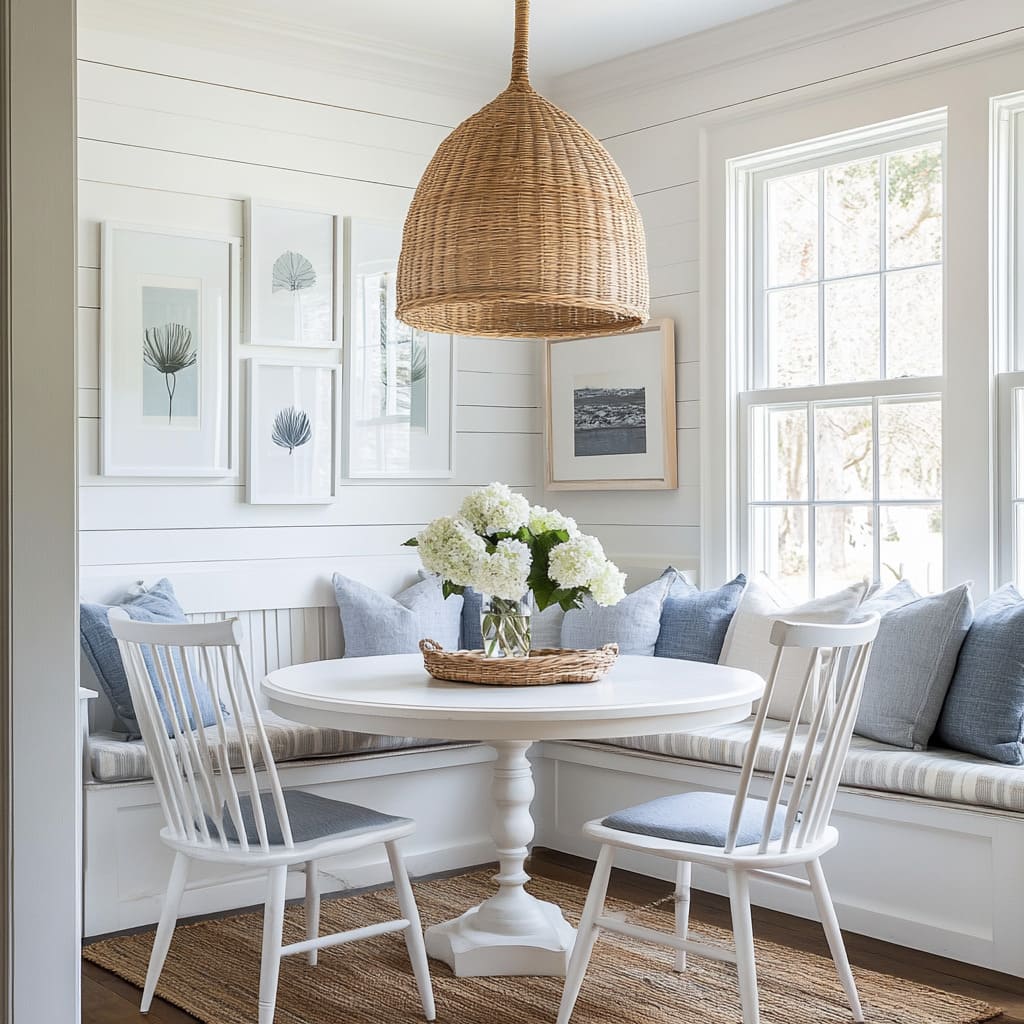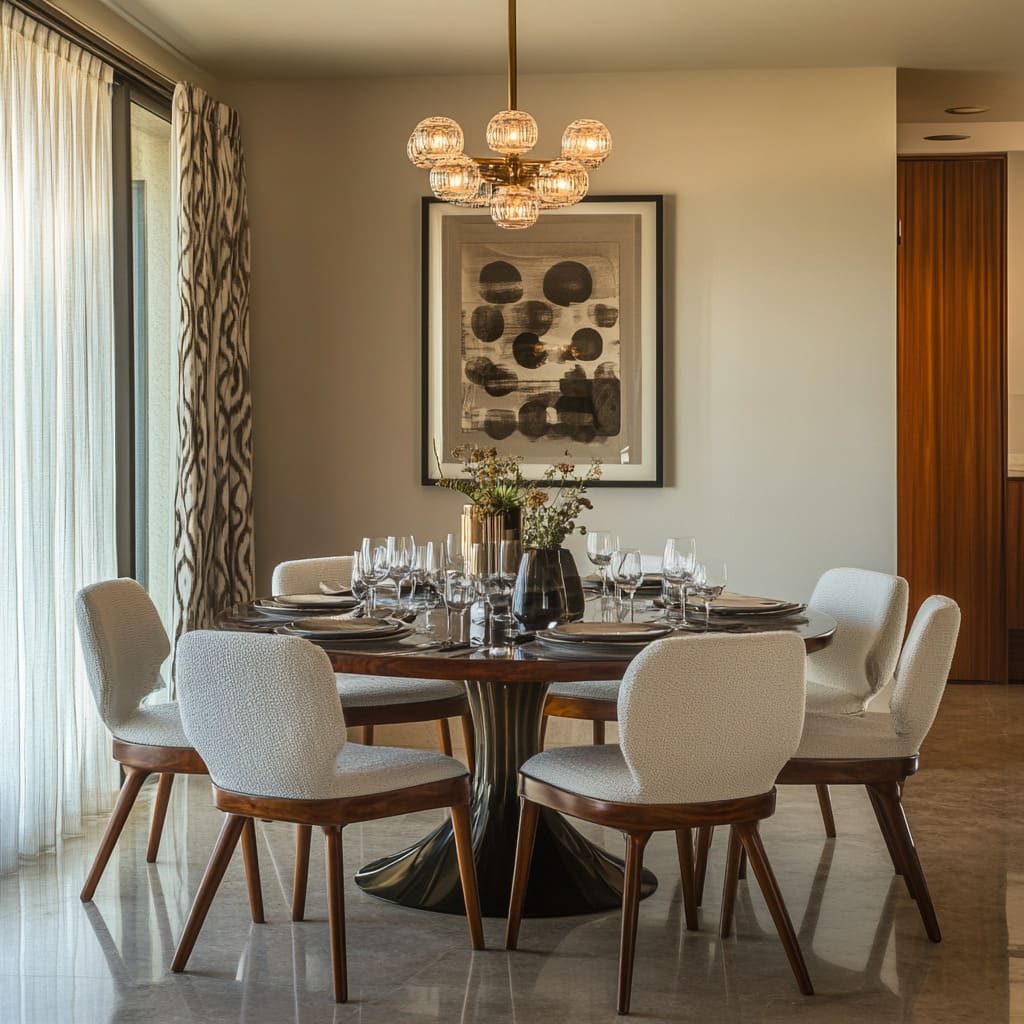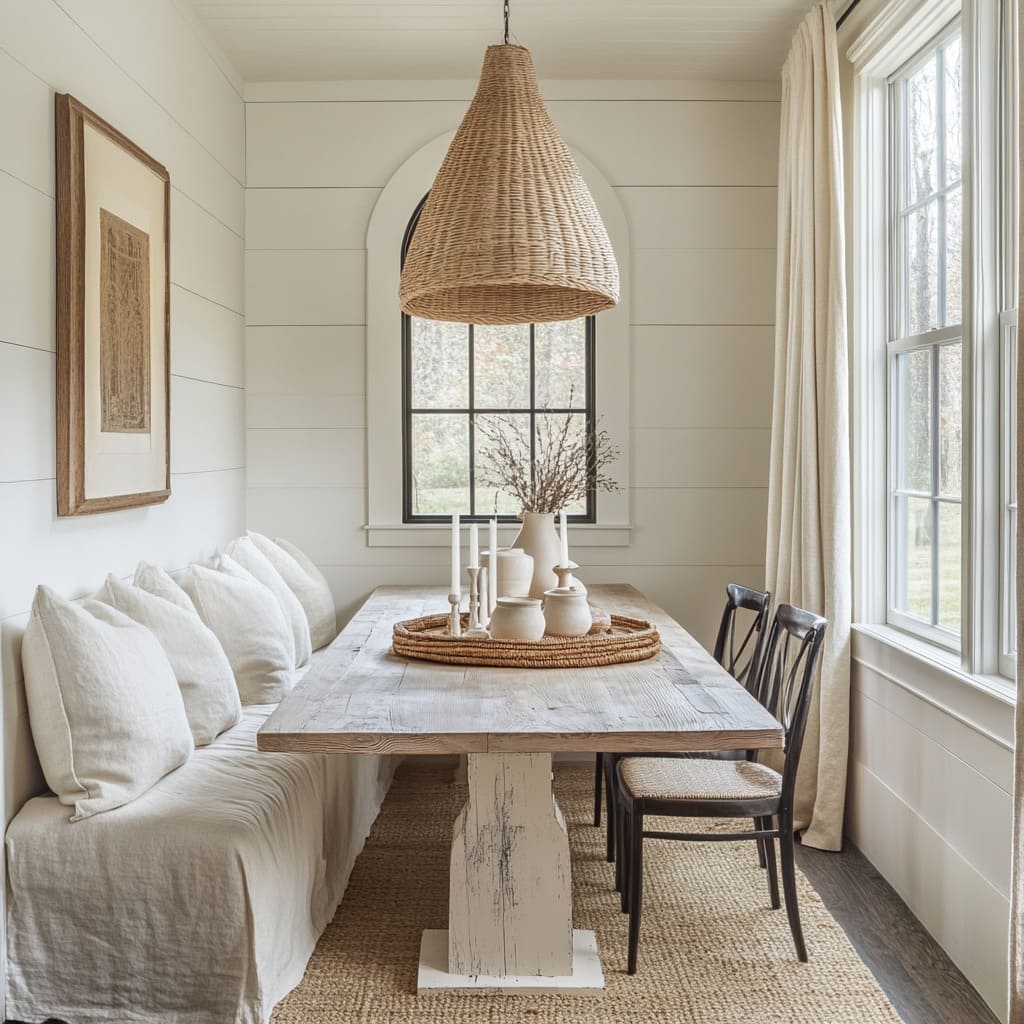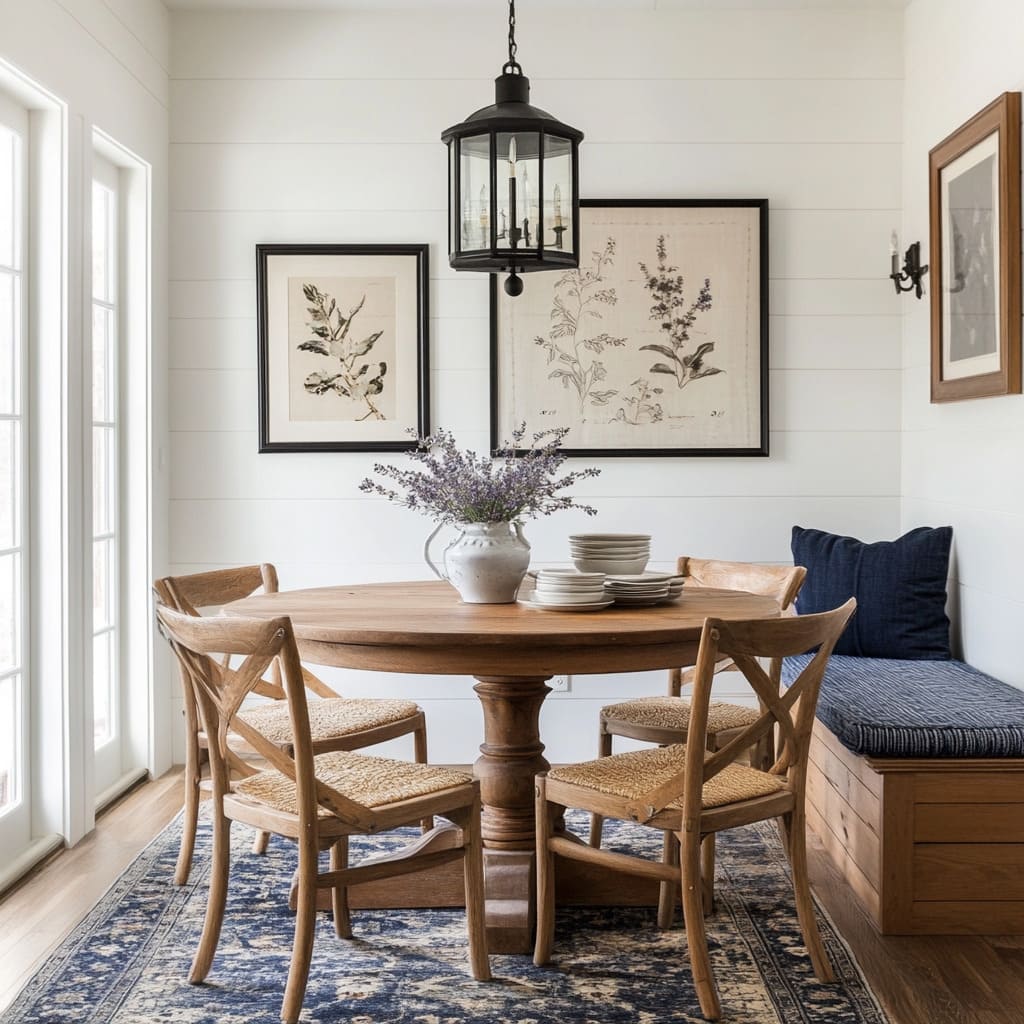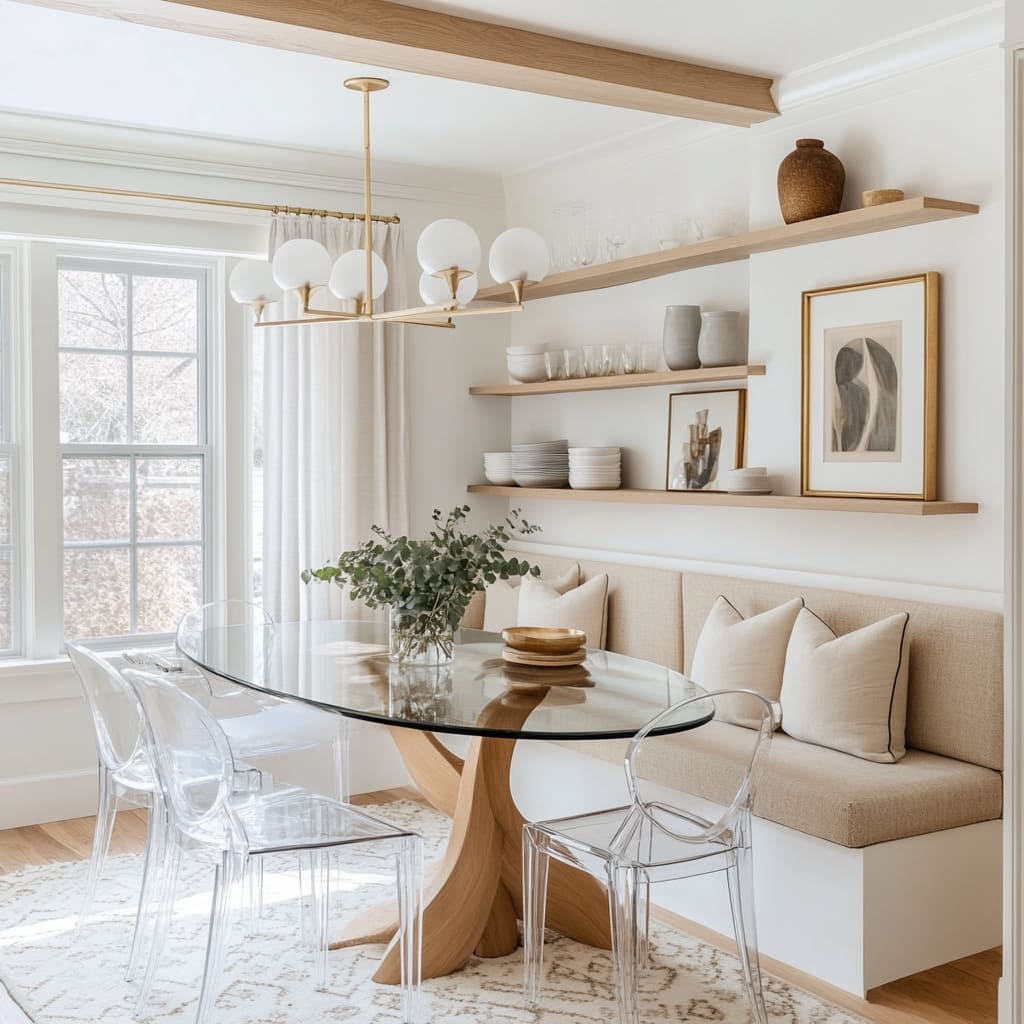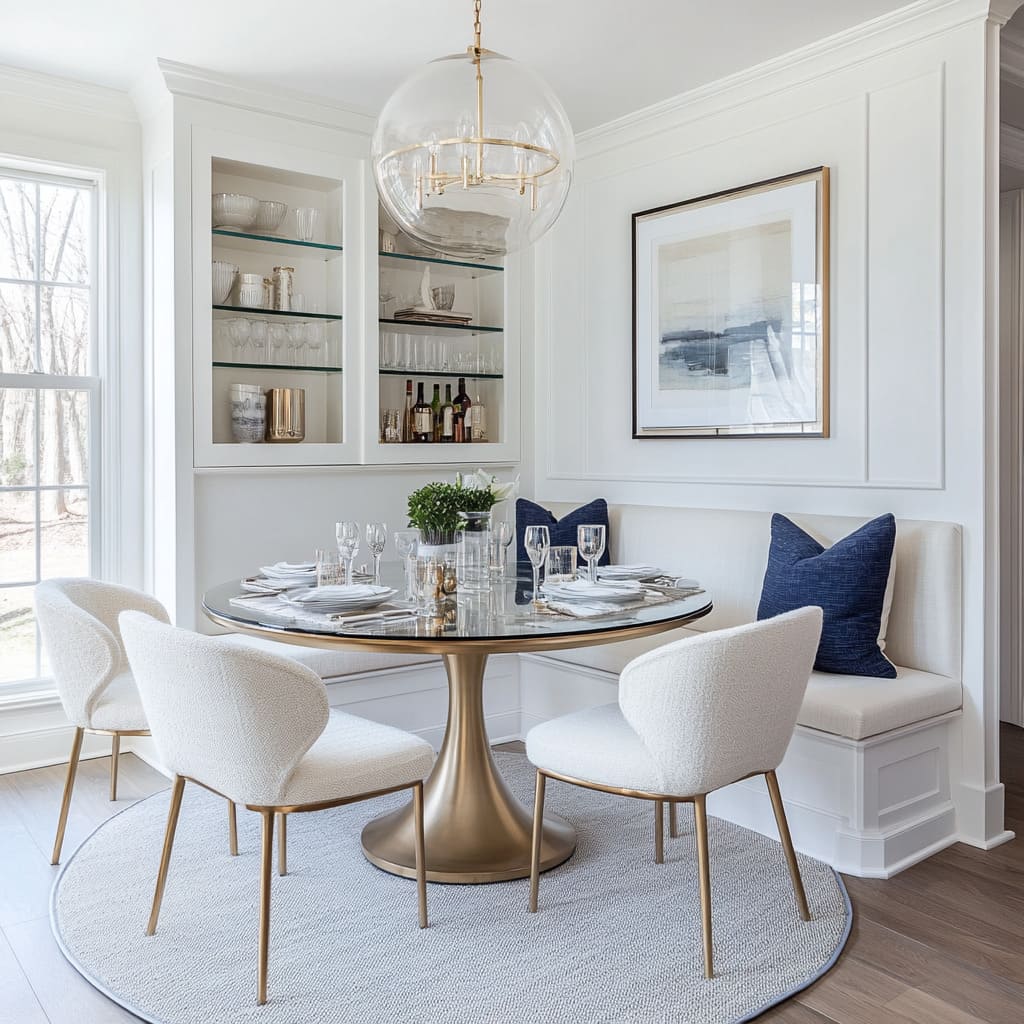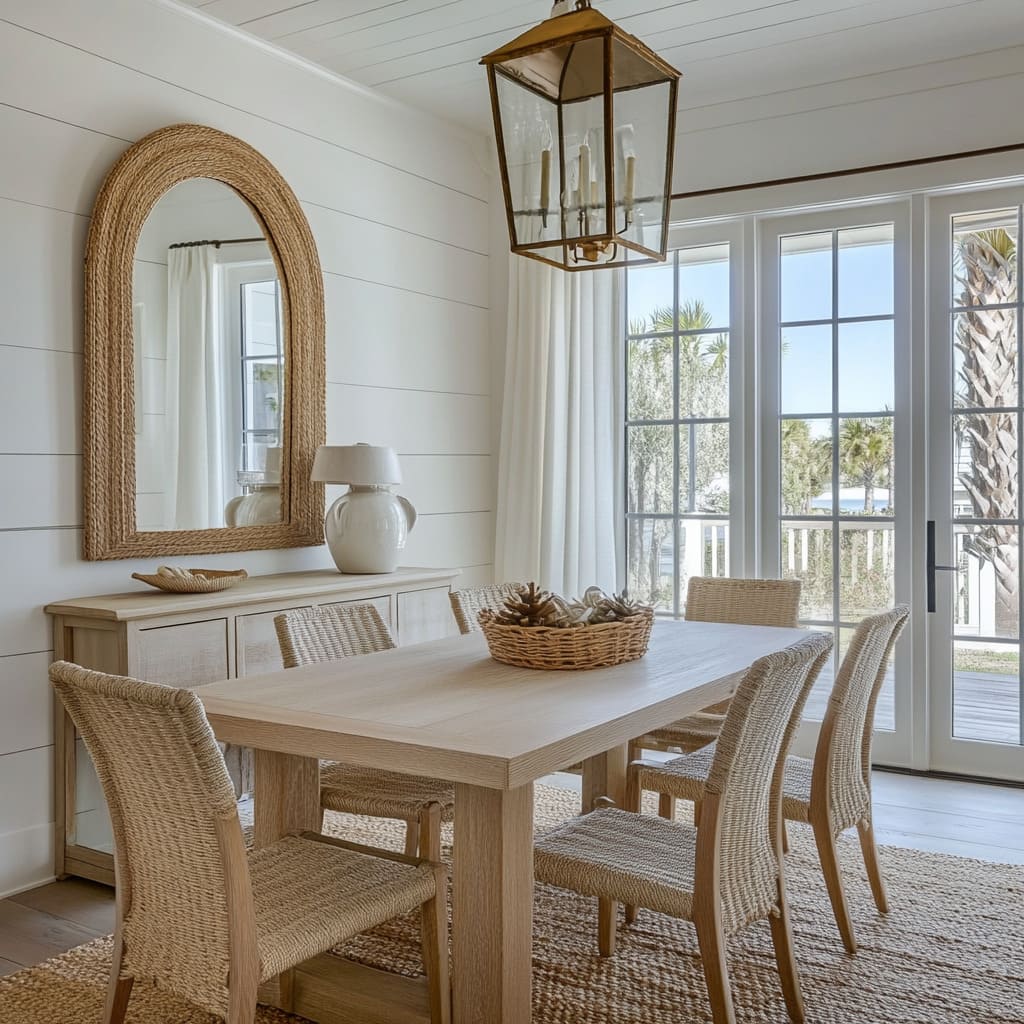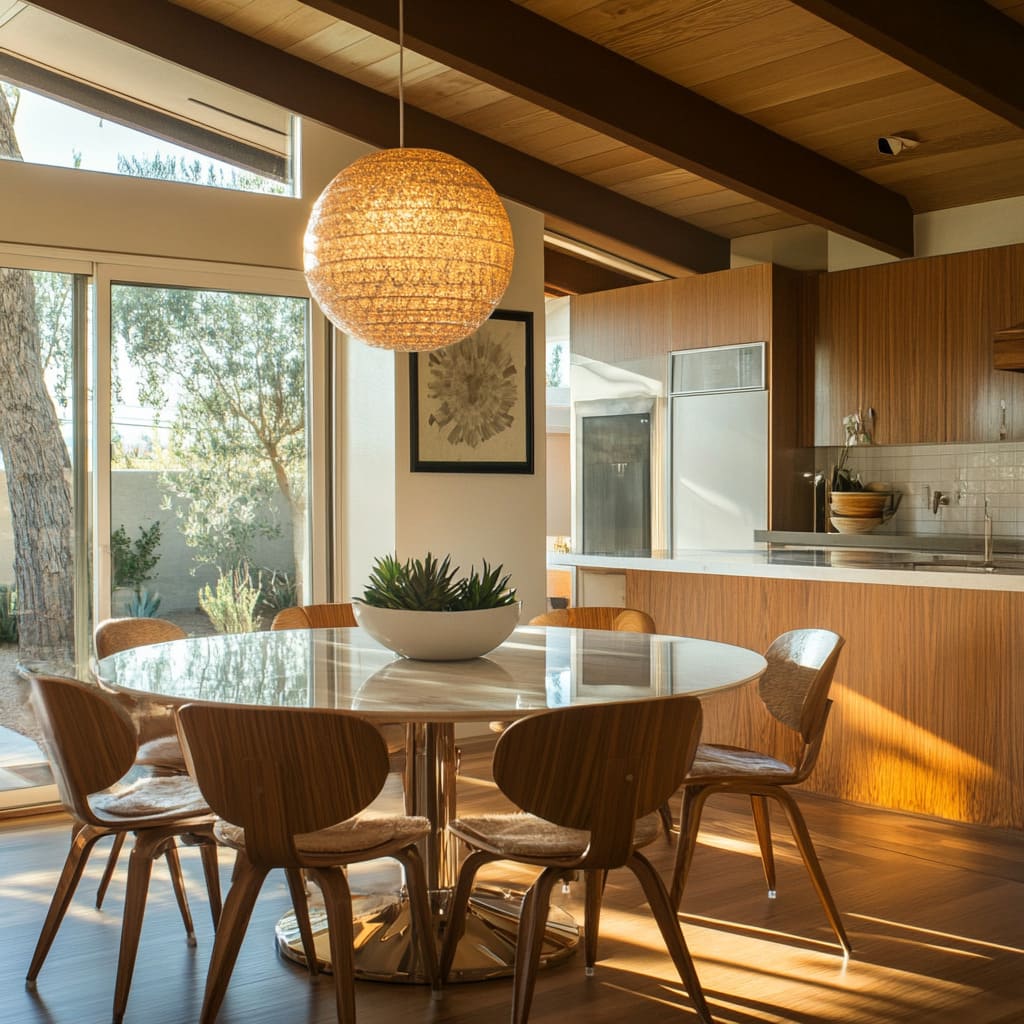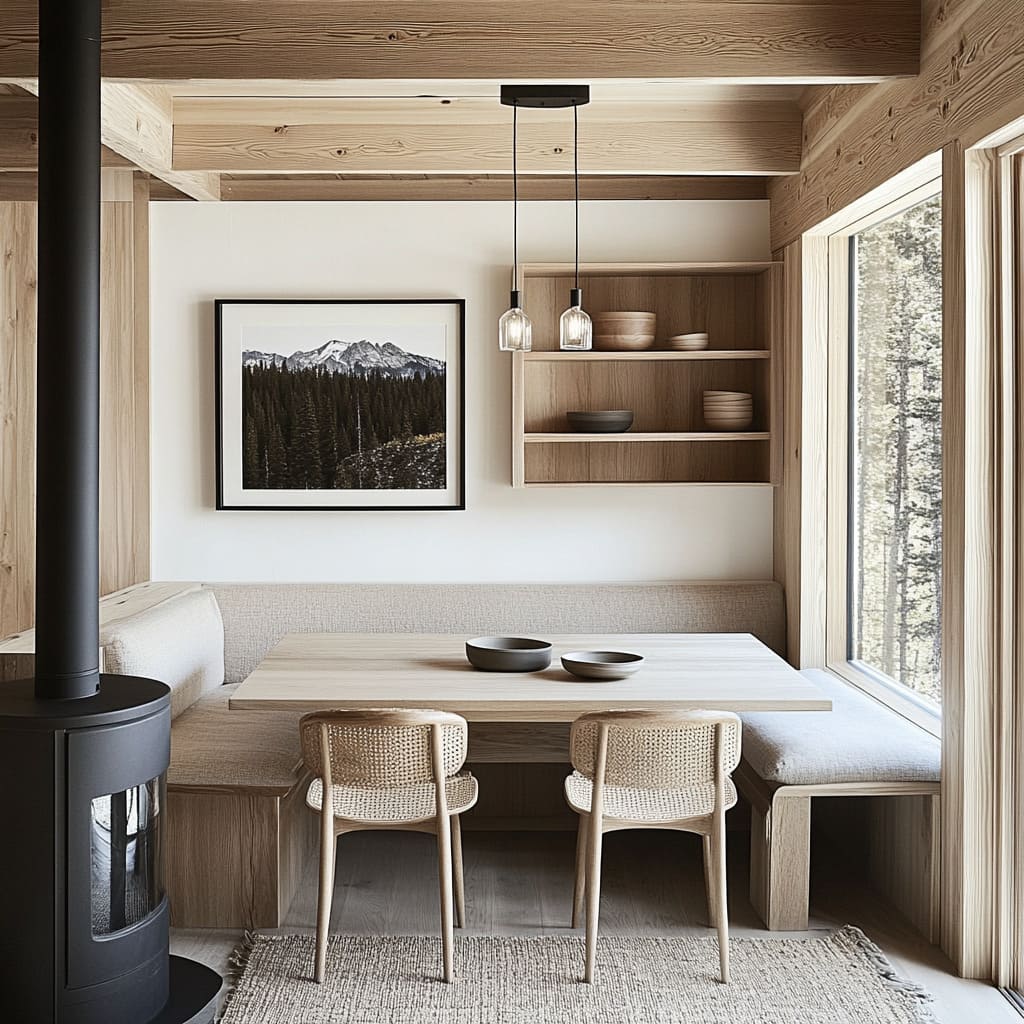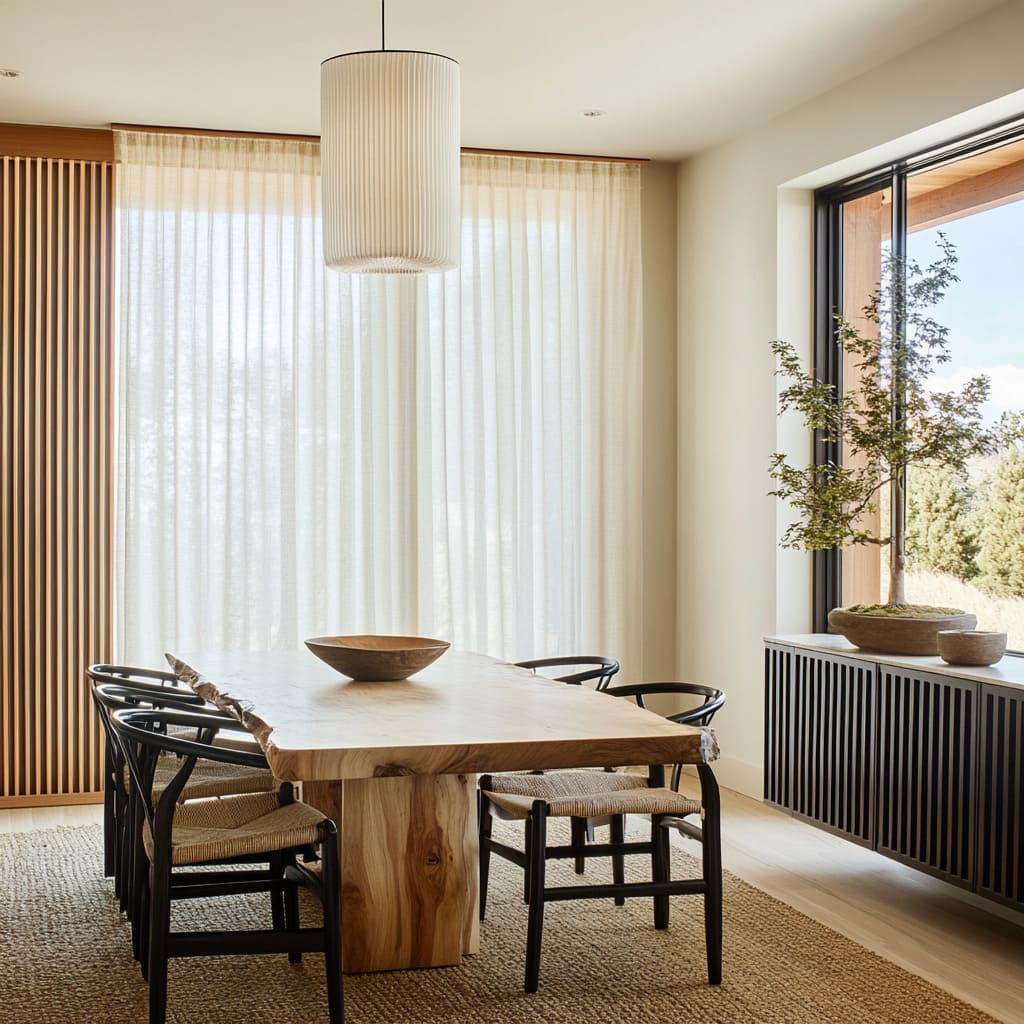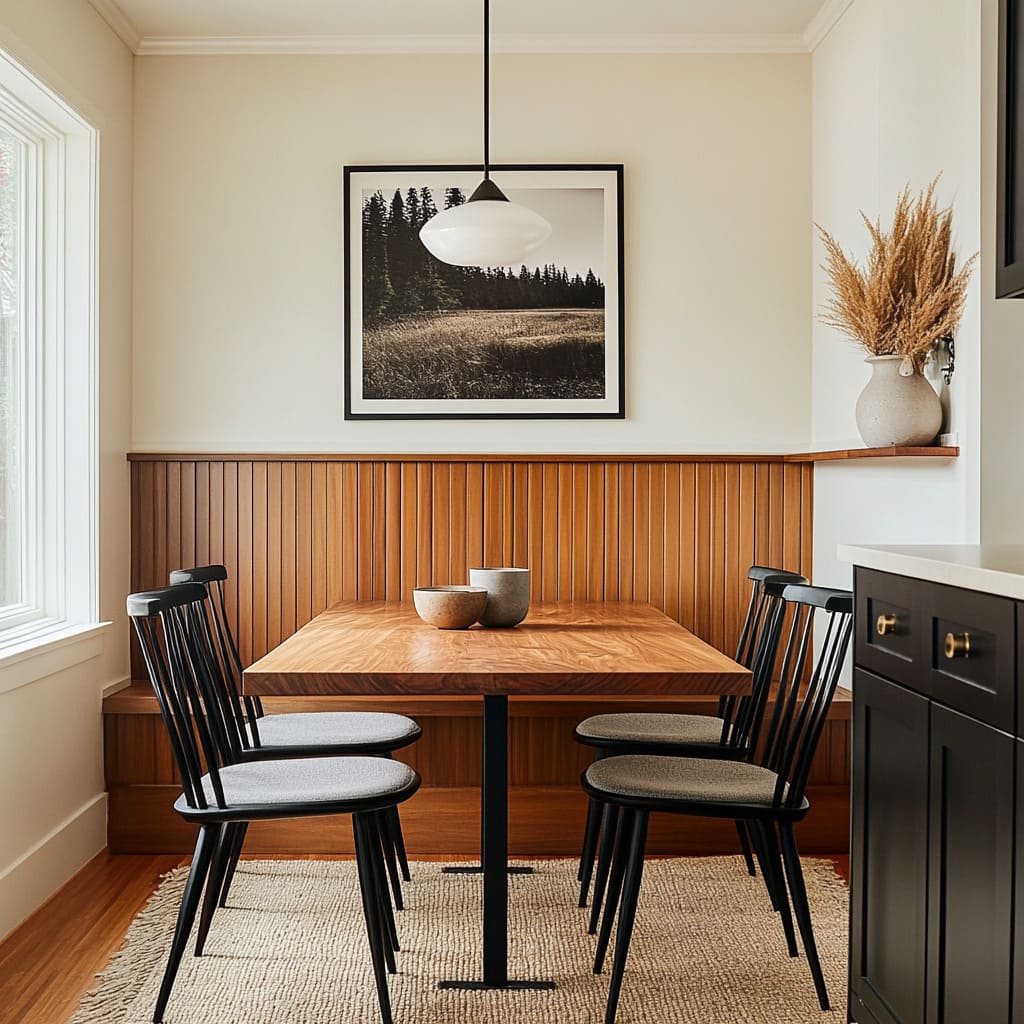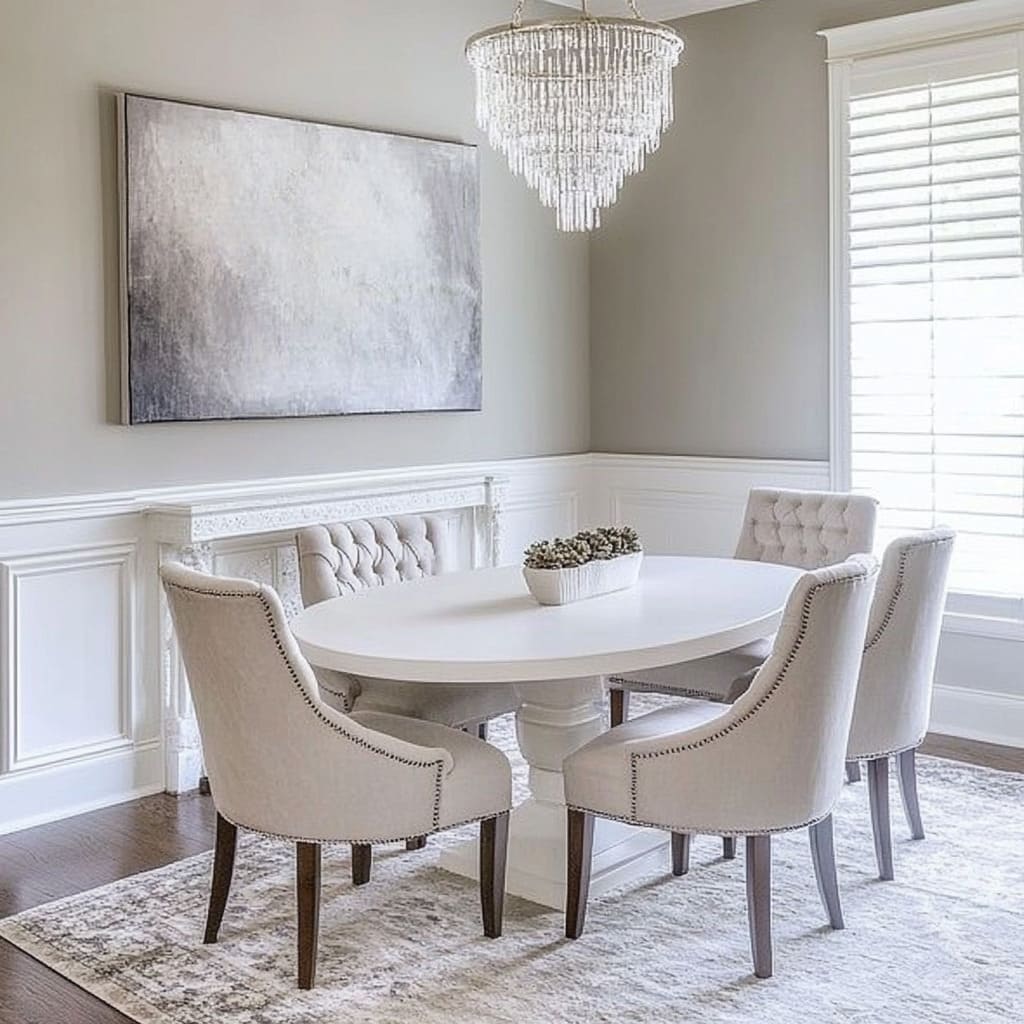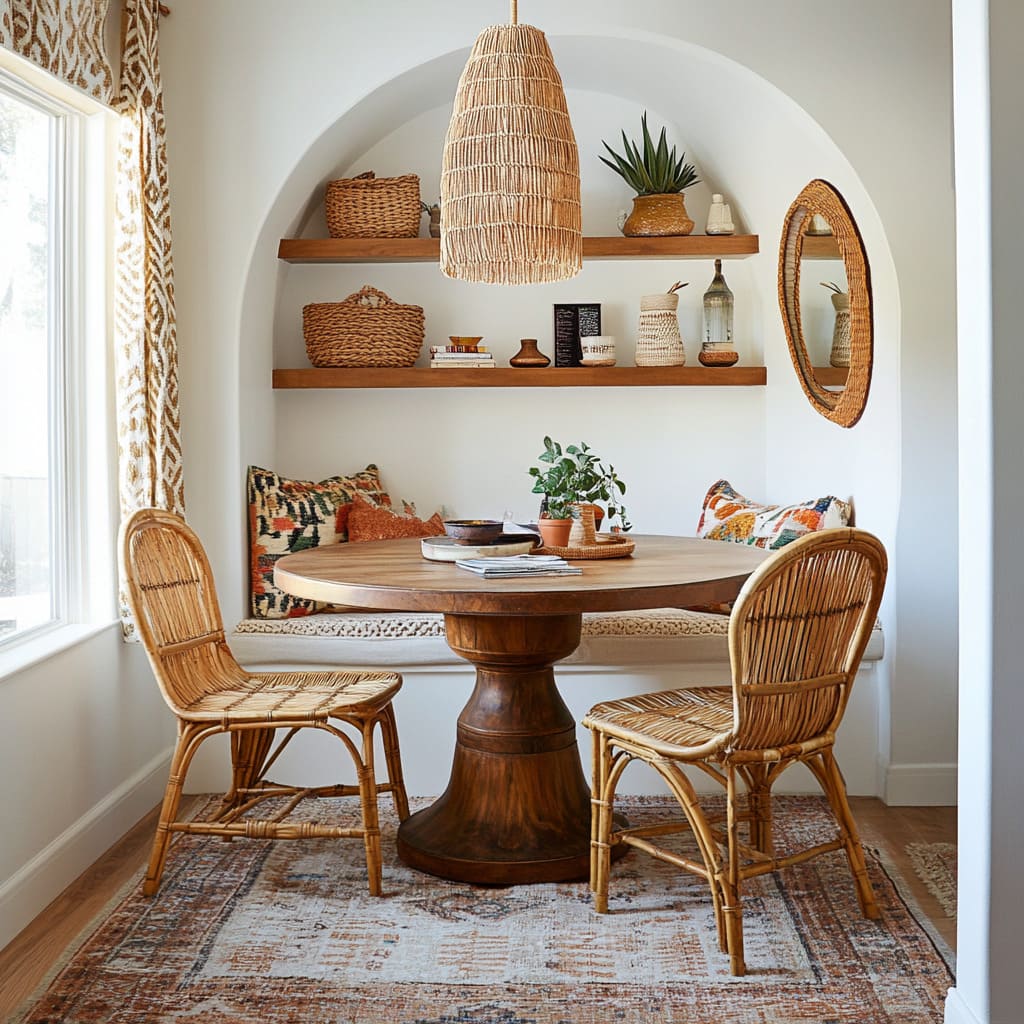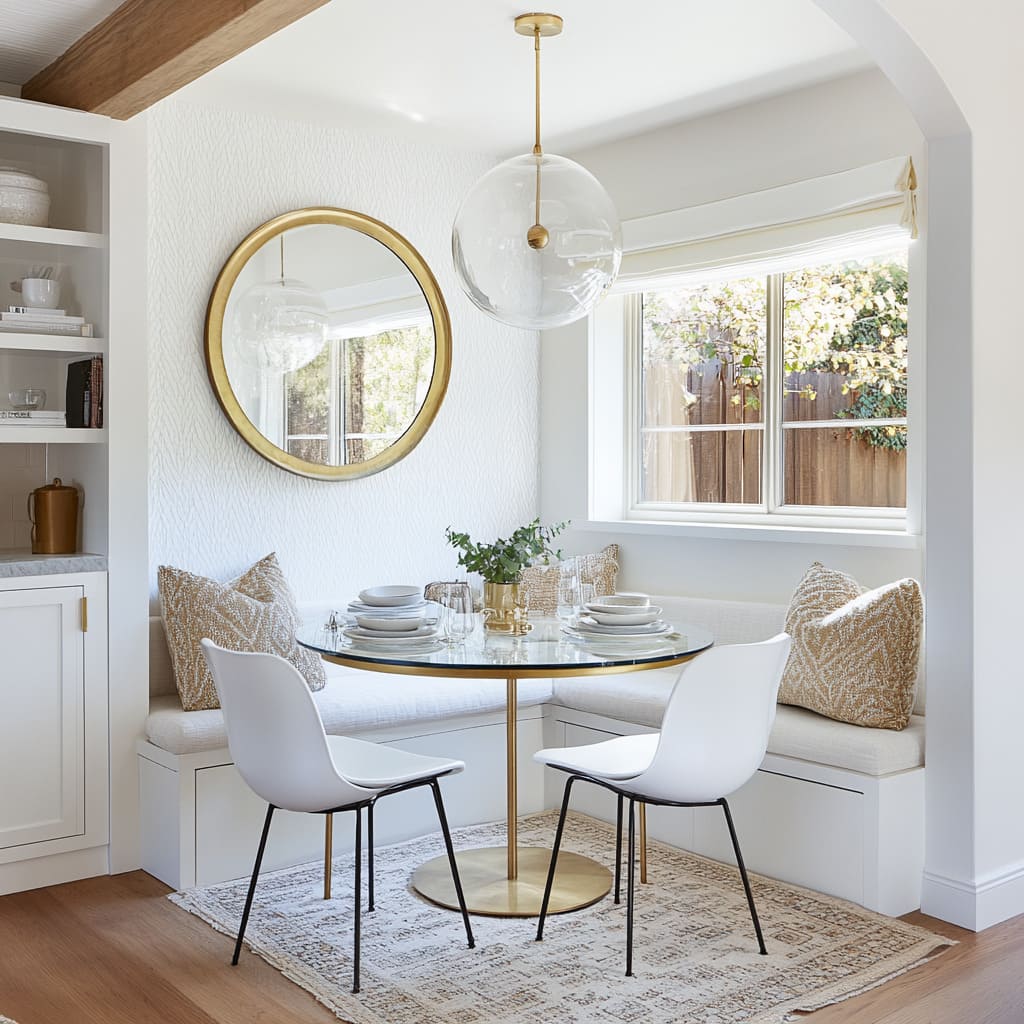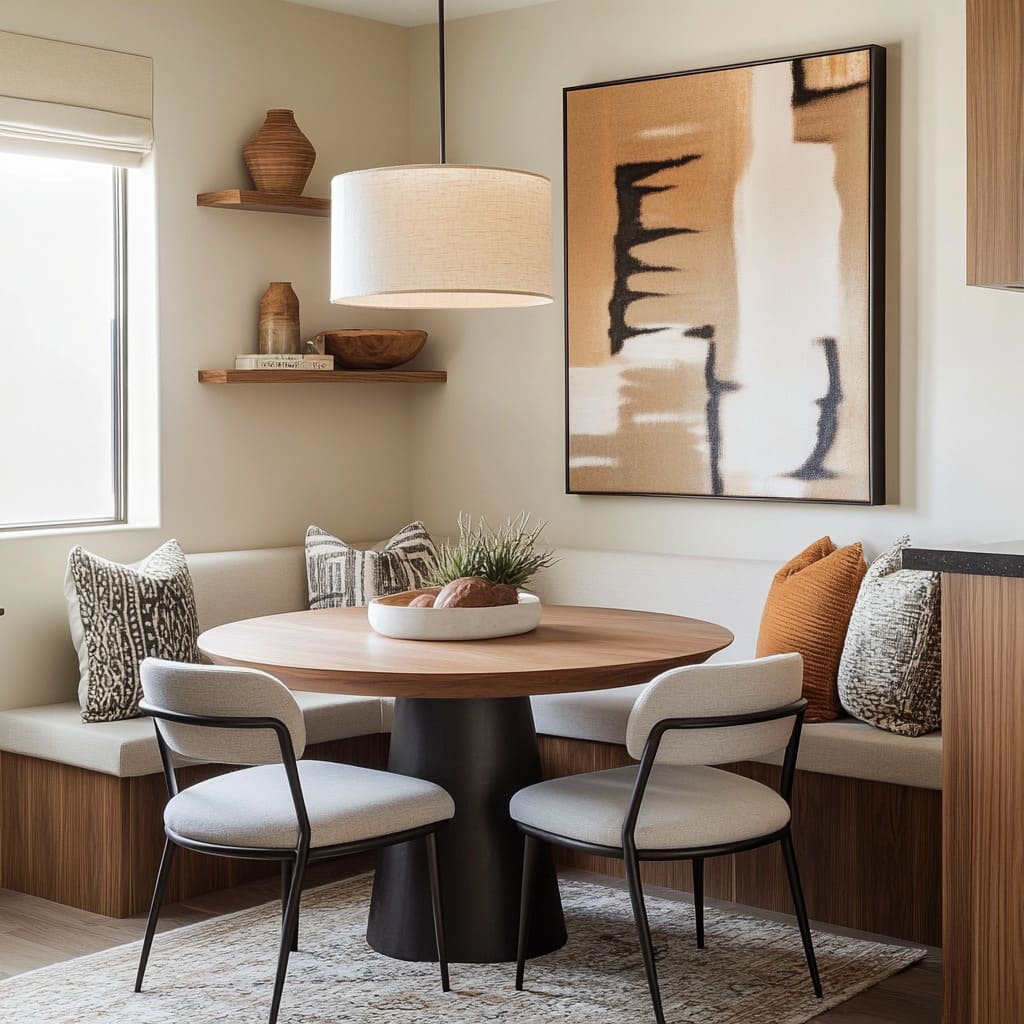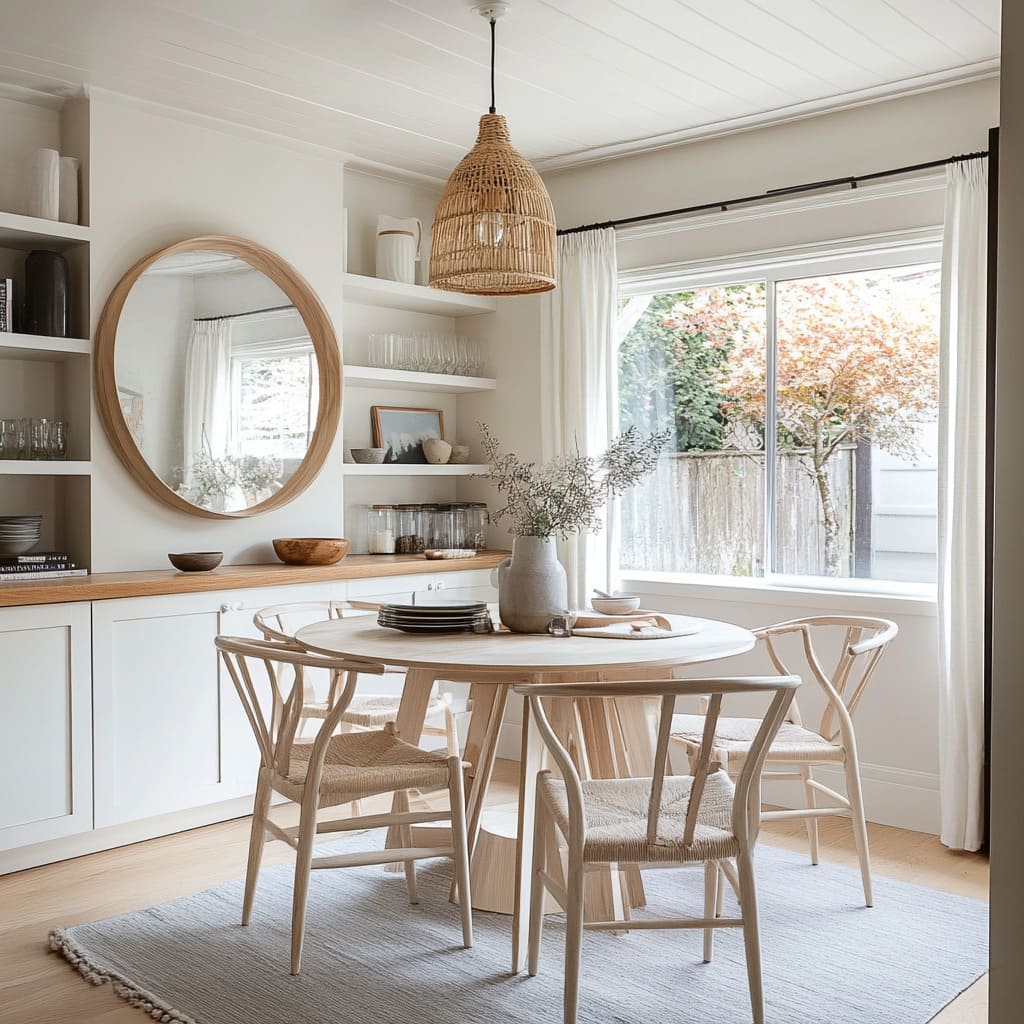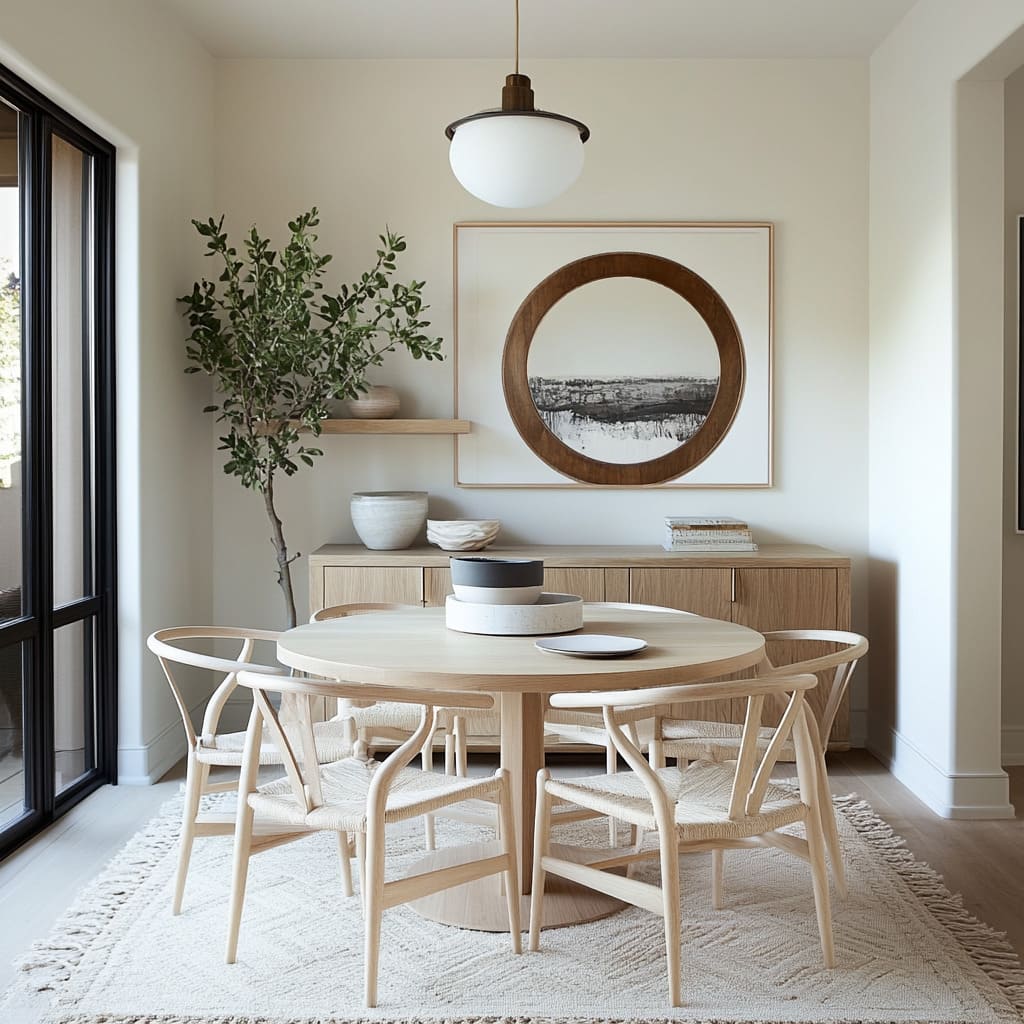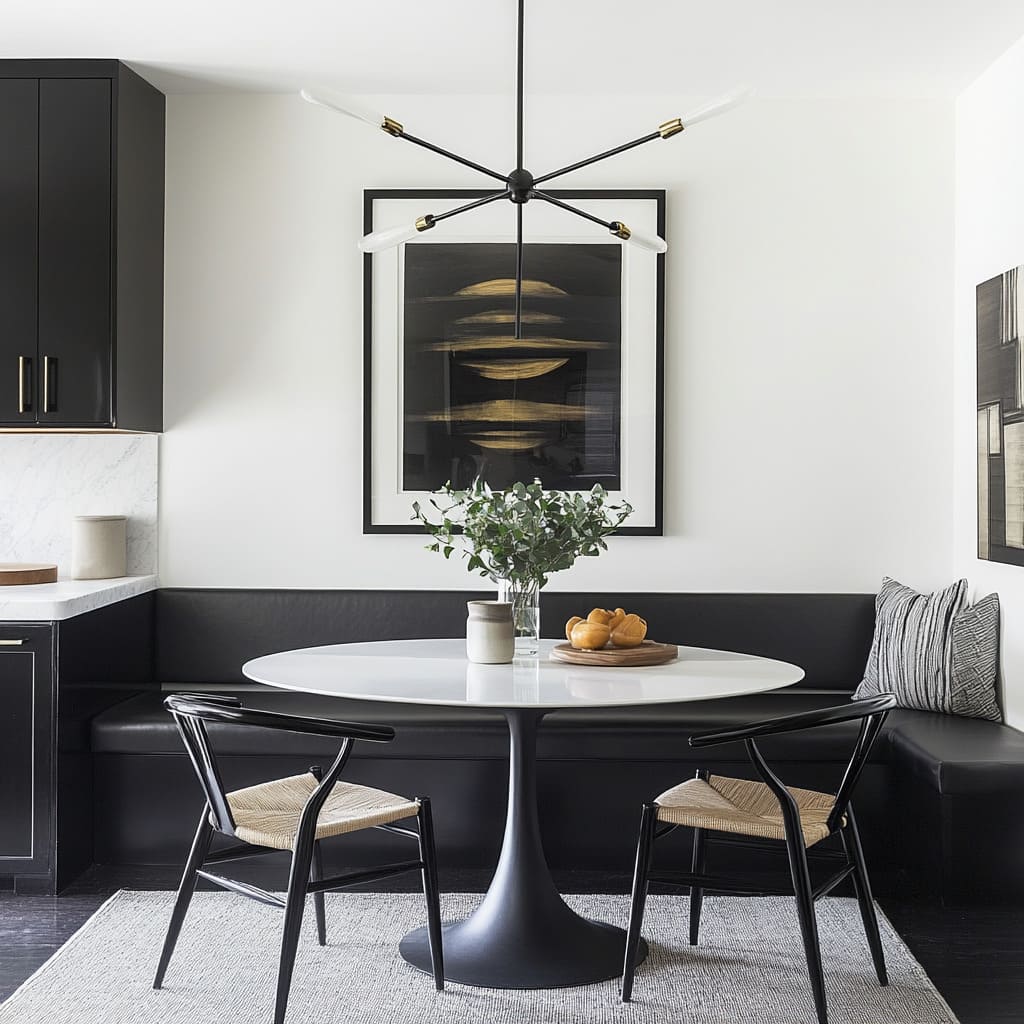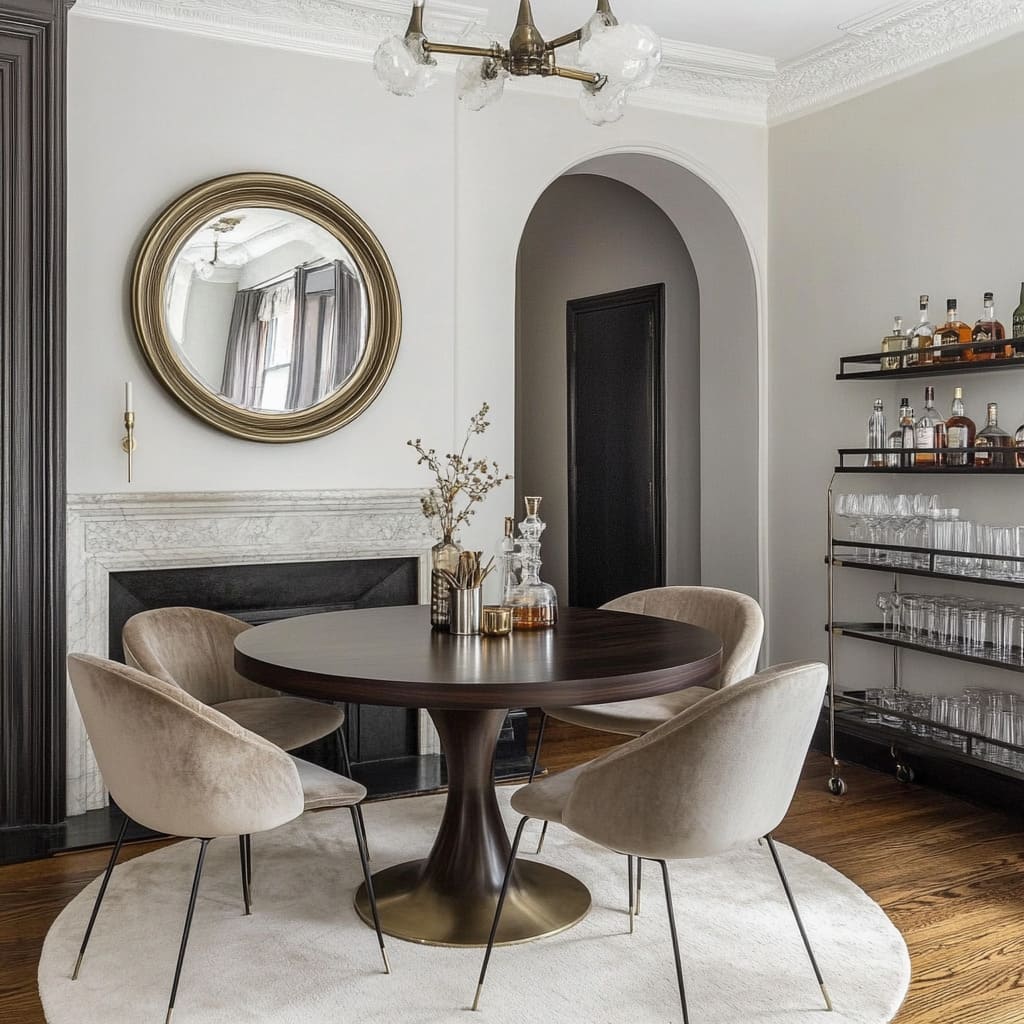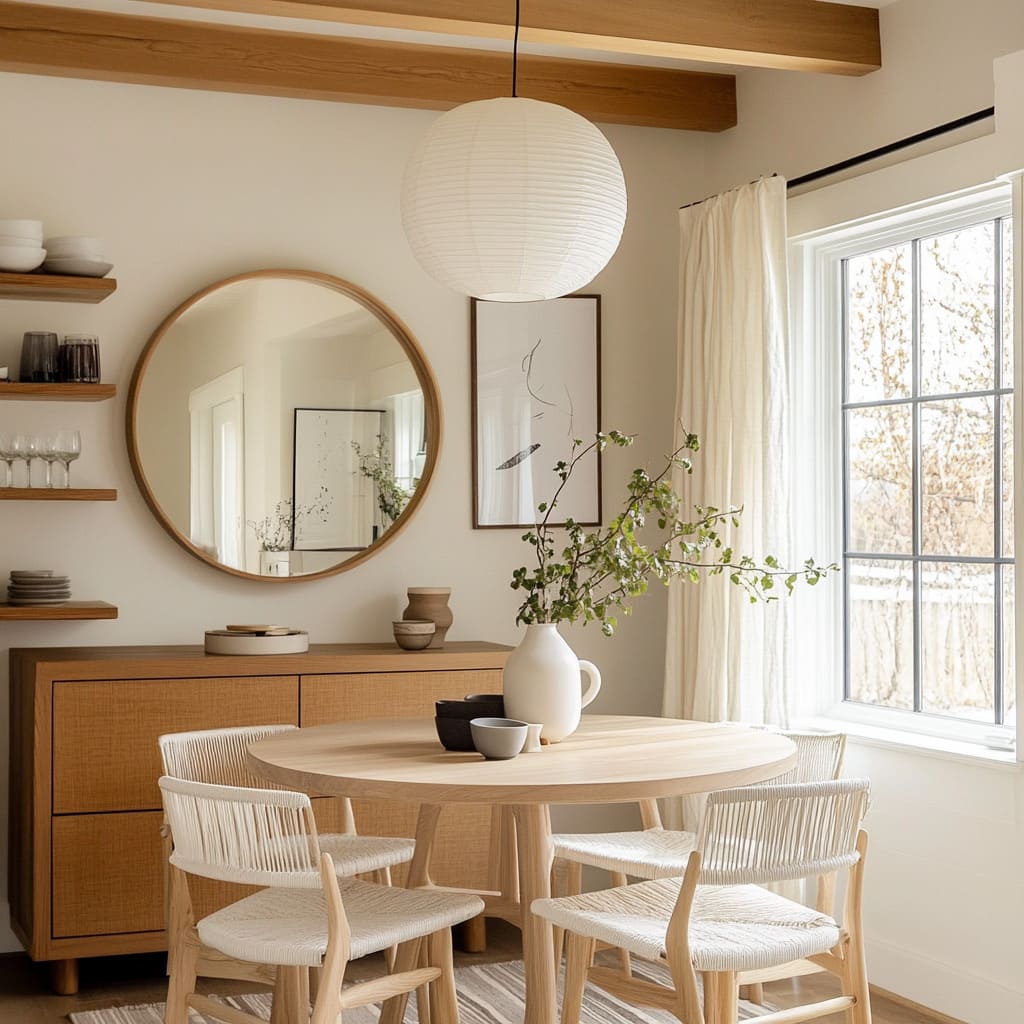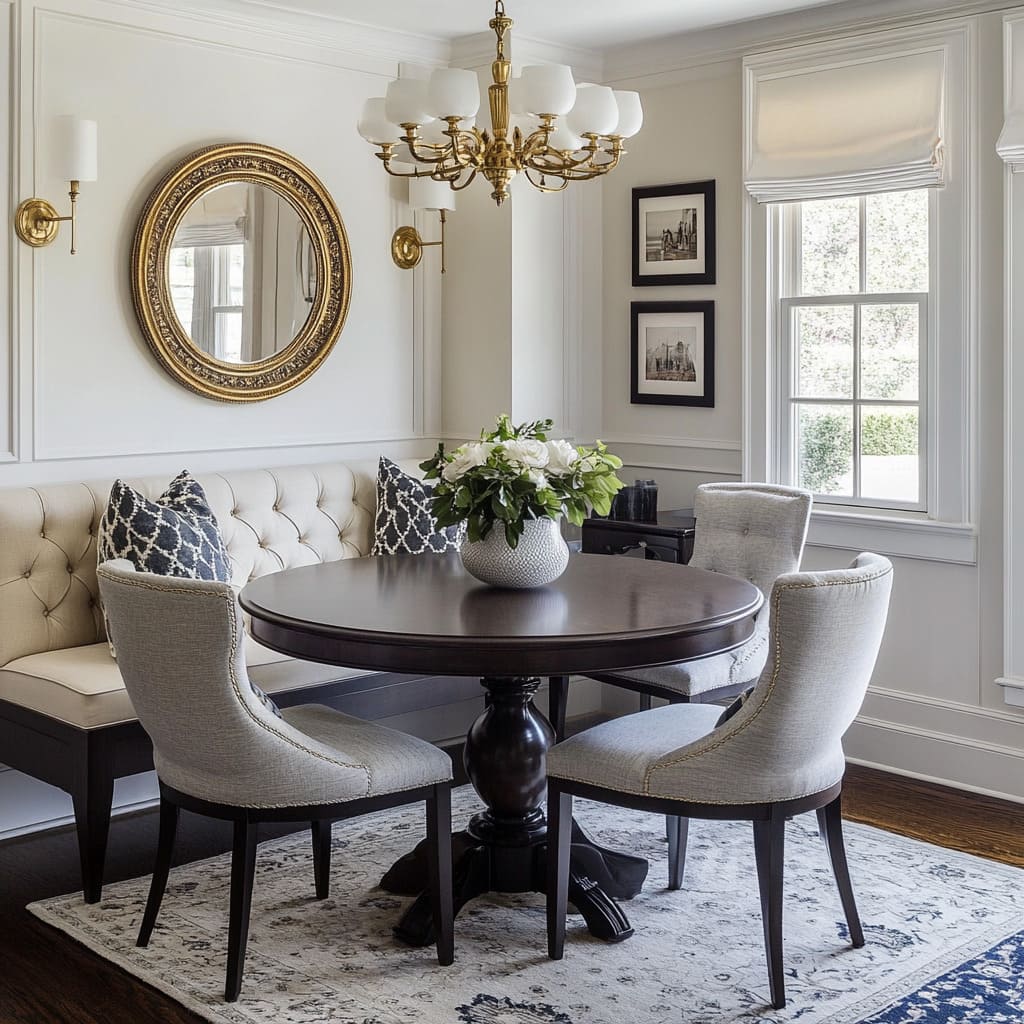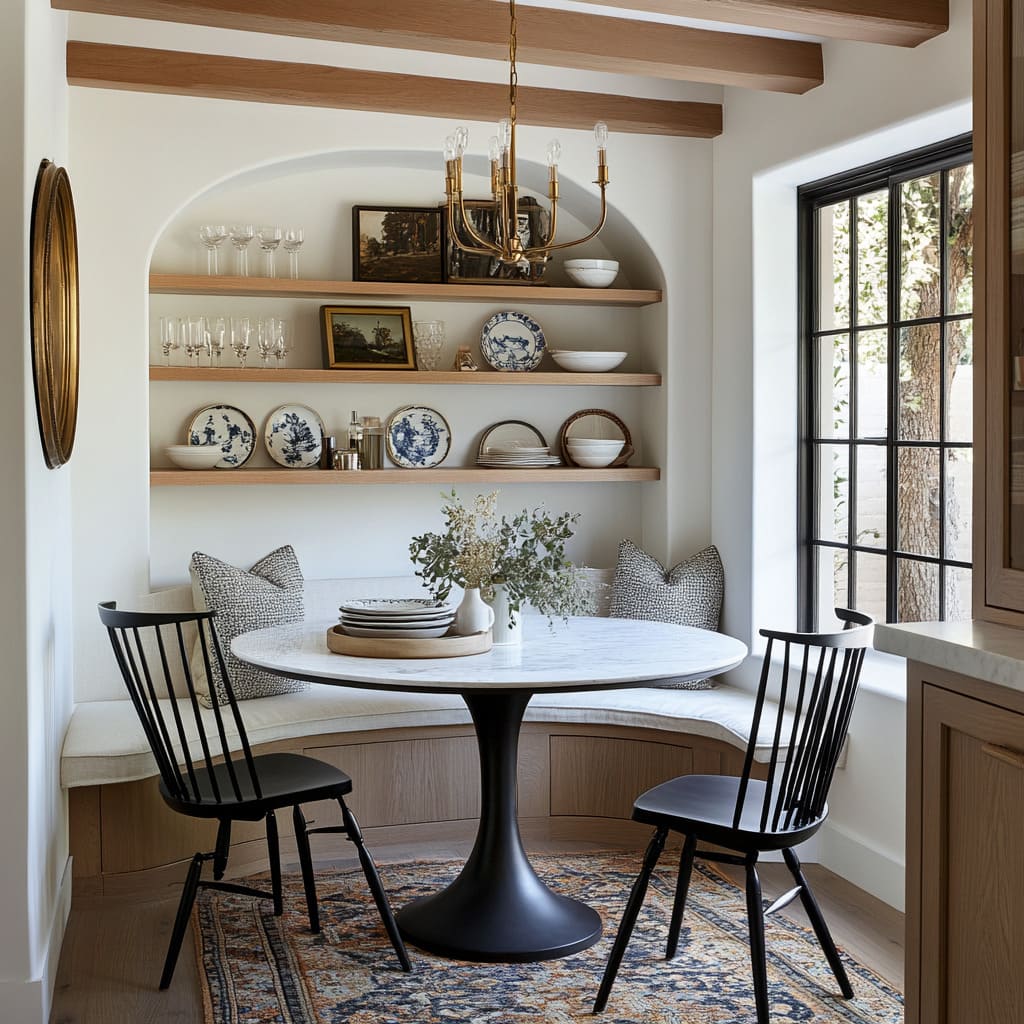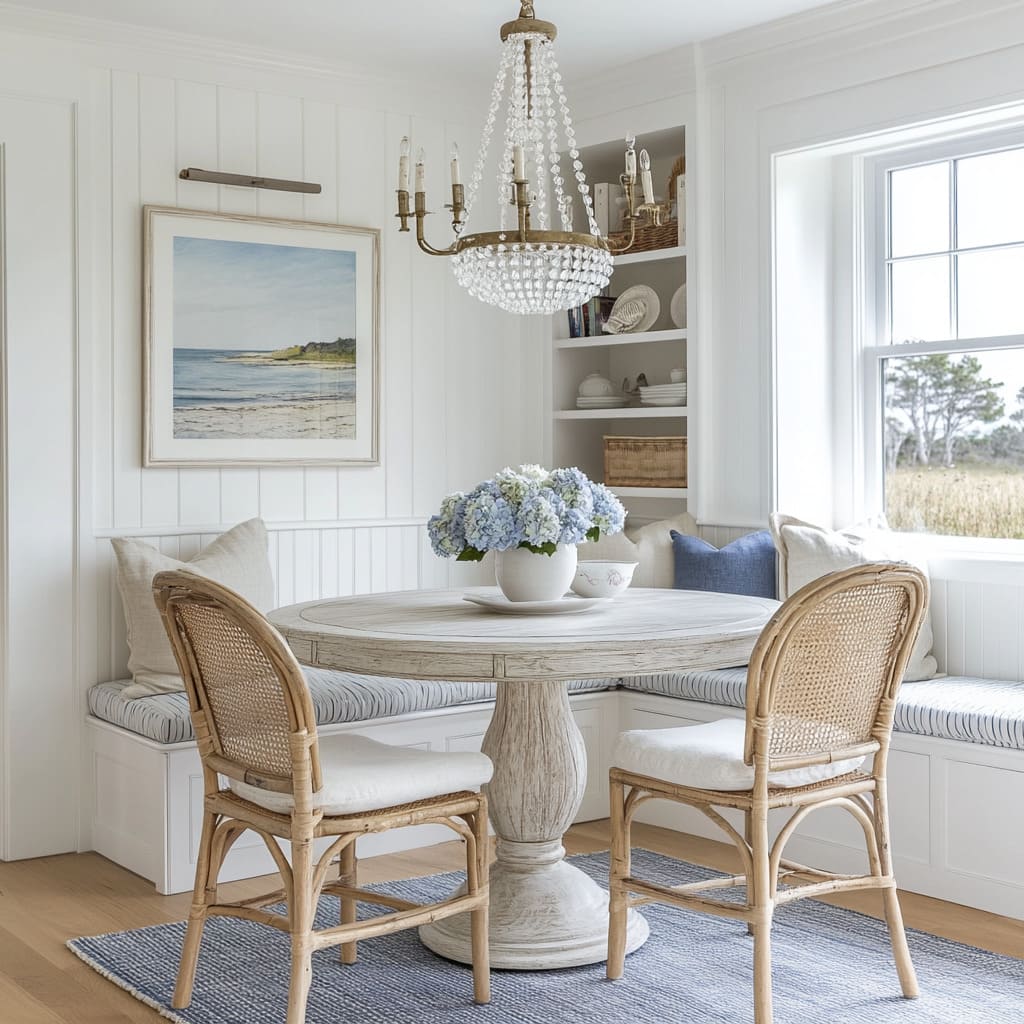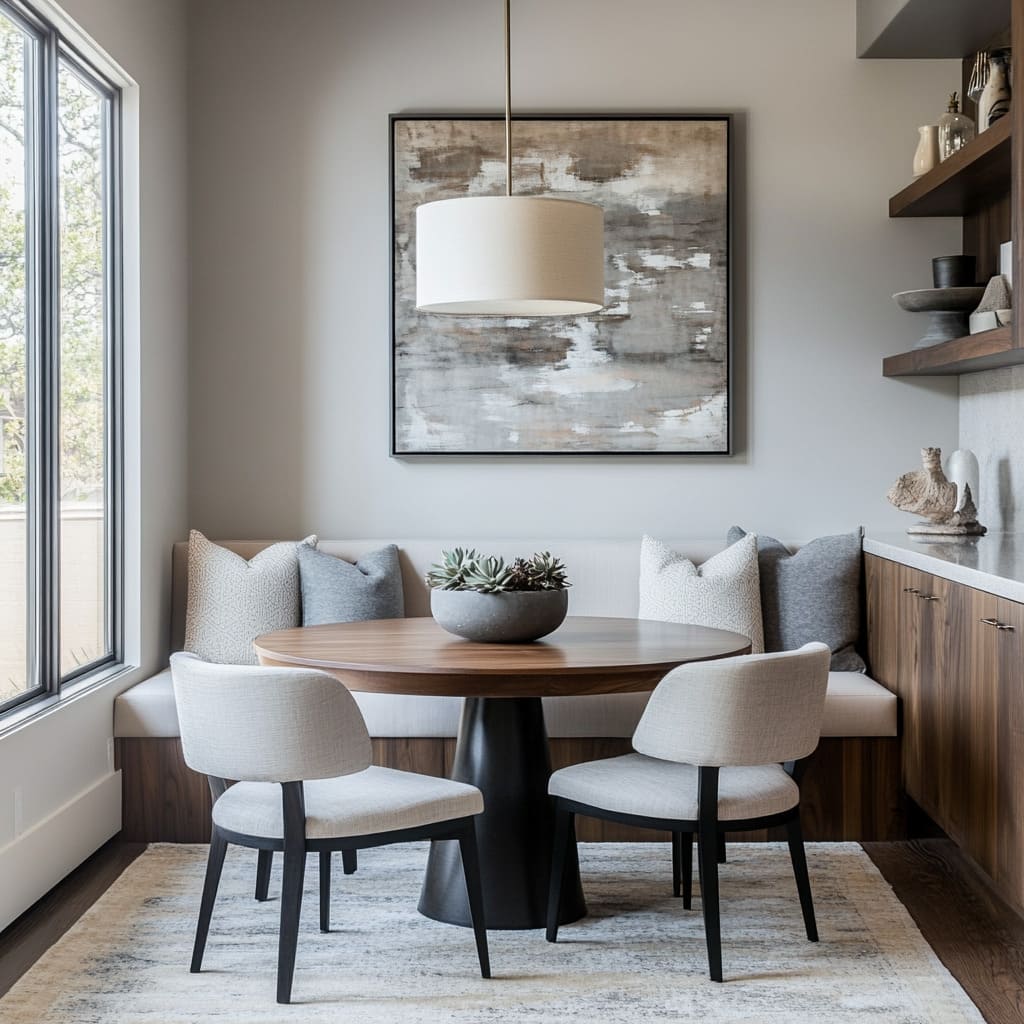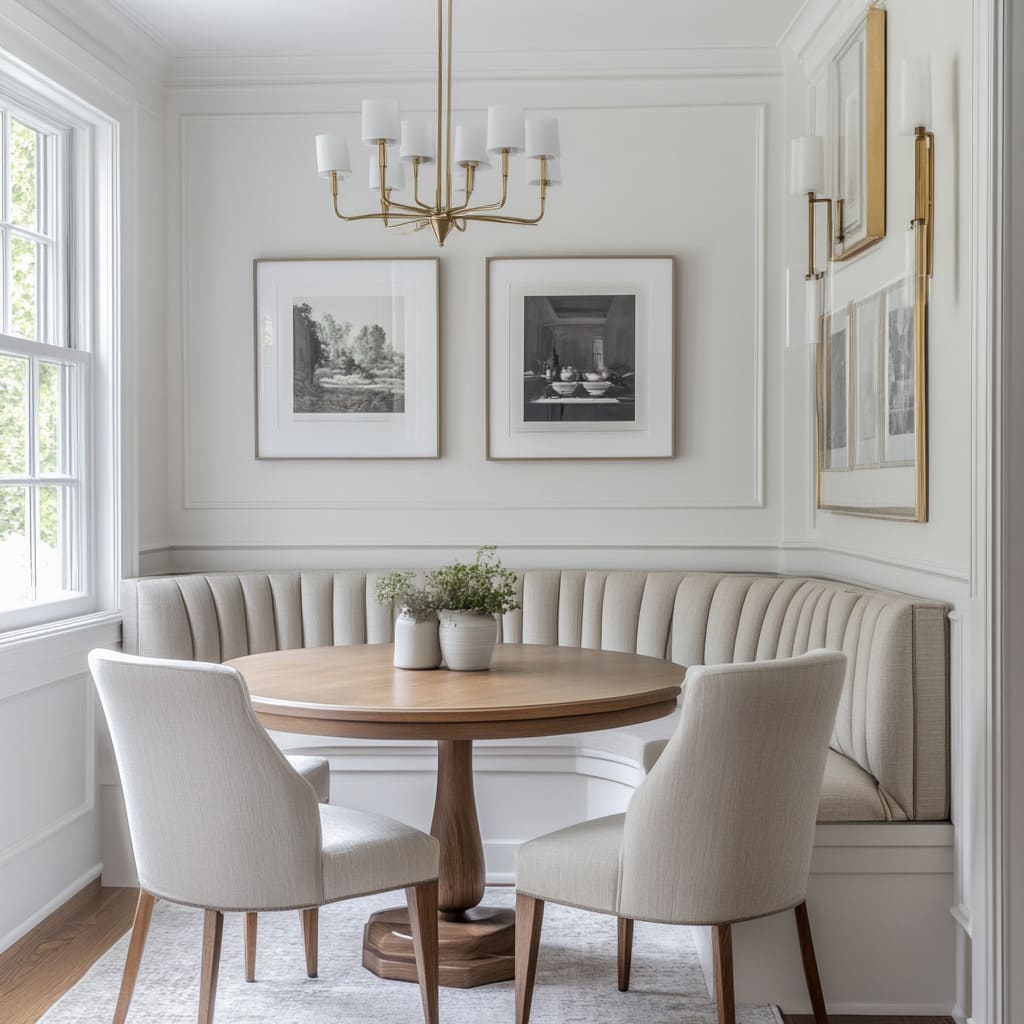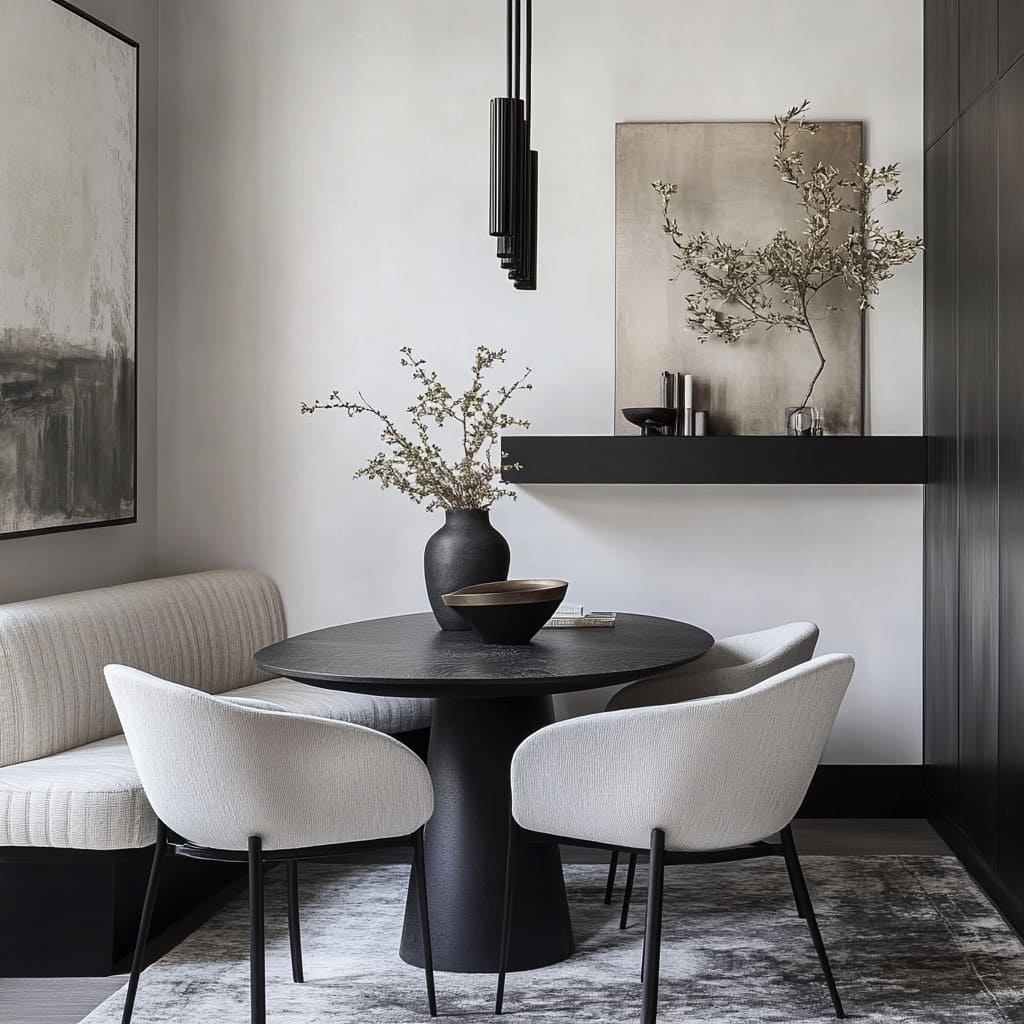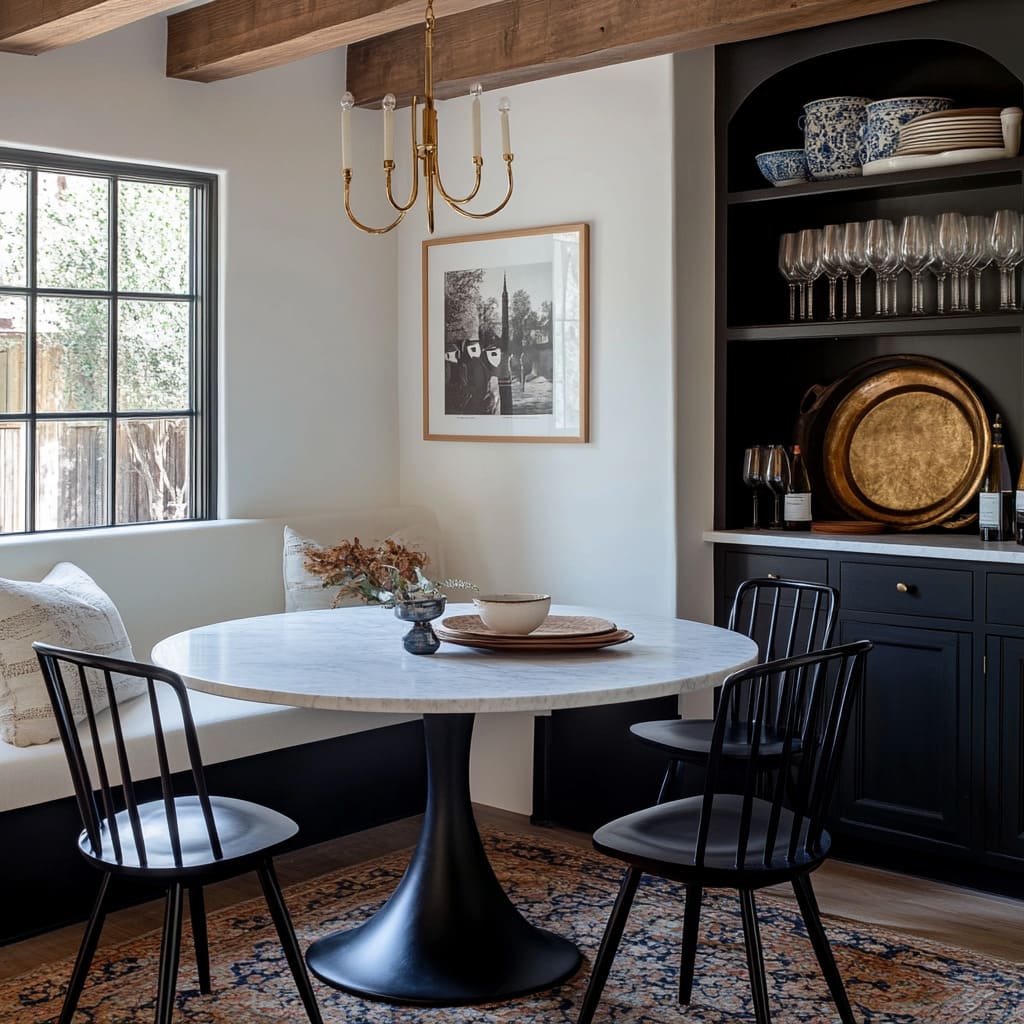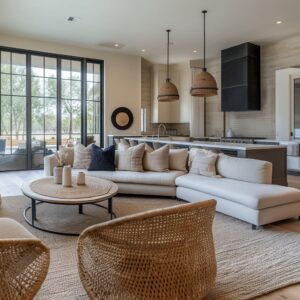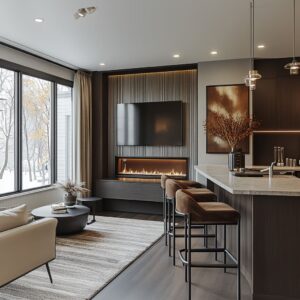Designing a compact dining area can feel like a challenge, but with the right approach, it can be just as functional and inviting as a larger space. Whether you’re working with a tiny breakfast nook, a corner in an open-plan layout, or a dedicated but compact dining room, smart planning and thoughtful design choices make all the difference.
From selecting the right table shape to using mirrors and lighting for an airy feel, there are plenty of small dining room ideas that maximize both style and practicality. The key is finding a balance between comfort and efficiency—choosing furniture that doesn’t overwhelm the room, incorporating hidden storage where possible, and using color and texture to create depth.
This guide explores creative ways to make a compact dining space feel intentional and beautifully designed. Whether you lean toward modern simplicity, cozy farmhouse charm, or a mix of styles, there’s always a way to tailor the space to your needs without sacrificing character.
The Power of Shape: How Curves and Geometric Repeats Make a Small Dining Area Feel Cohesive
A well-designed dining nook is more than just a collection of furniture—it’s a carefully arranged composition where shapes and forms work together to create balance. One of the most effective ways to achieve a visually pleasing layout in a compact space is by repeating circular or rounded elements.
This subtle design trick softens harsh edges, ensures smooth transitions, and brings a sense of flow to a small dining area.
Why Rounded Shapes Work So Well in Small Dining Areas
Too many sharp angles in a compact setting can make a room feel boxed in. That’s where curved silhouettes step in, easing visual tension and making the space feel more inviting.
Many successful small dining area ideas rely on repeating rounded shapes across key elements—whether it’s a circular table, arched seating, a curved-back chair, or a rounded mirror. This repetition creates a sense of continuity that feels deliberate rather than accidental.
Even built-in banquettes, a favorite for maximizing tight layouts, often mirror the shape of the table they accompany. A wraparound bench that curves around a round or oval table not only makes better use of the available floor space but also enhances the sense of enclosure, making the area feel snug rather than restrictive.
Matching Chairs to Tables for a Cohesive Look
The way chairs relate to the table plays a significant role in how balanced a dining area feels. A rounded table naturally pairs well with chairs that have curved backs or tapered legs, reinforcing the gentle, organic flow of the space.
On the other hand, a rectangular table looks best when accompanied by seating with clean, structured lines. This approach ensures that the furniture doesn’t feel mismatched but instead works as a cohesive unit.
How to Apply This in Your Own Dining Space
When designing a small dining area, think about repeating a single shape across multiple elements. A round dining table paired with a spherical pendant light and a circular mirror can create a rhythm that feels intentional and visually soothing.
If you prefer an oval or rectangular table, look for ways to echo that shape in the surrounding furniture—perhaps through arched shelving, curved chair backs, or even a soft, rounded rug to anchor the space. By incorporating these thoughtful design choices, a compact dining nook can feel far more spacious and harmonious, proving that even the smallest details can have a big impact on the overall look and feel of a space.
How Reflective Surfaces Can Make a Small Dining Space Feel Bigger and Brighter
In a compact dining area, the right materials can completely change how the space feels. Reflective surfaces—whether glass, acrylic, mirrors, or subtle metallic details—can visually open up a room, making it feel brighter and more inviting.
By strategically placing these elements, a dining space can avoid feeling boxed in while maintaining a stylish and polished look.
Glass and Acrylic: Keeping the Room Visually Light
One of the easiest ways to create a sense of openness in small dining ideas is through transparent materials. A glass or acrylic dining table allows light to pass through, preventing the furniture from feeling heavy.
Even in a room with dark cabinetry or bold wall colors, a glass tabletop ensures the space doesn’t feel weighed down. Acrylic chairs work in a similar way—offering seating without visually cluttering the area.
These pieces are especially useful in narrow dining nooks, where every inch matters.
Mirrors: The Ultimate Space-Expanding Trick
A well-placed mirror can do more than just reflect a beautiful dining setup—it can completely shift the perception of space. When positioned across from a window, a large mirror doubles the natural light, making the room feel airier.
Even in a dining corner with limited daylight, a mirror opposite a doorway can extend the sense of depth, creating the illusion of a much larger area. Many stylish dining room decorating ideas include round or brass-framed mirrors to complement the décor while enhancing the brightness.
Metallic Accents: A Subtle Glow Without Overpowering
Not all reflective surfaces have to be obvious. Small touches of metal—whether in the form of brushed gold pendant lights, bronze cabinet pulls, or a black metal table base—bounce light gently without being overwhelming.
Unlike high-gloss finishes, which can sometimes feel stark, these materials add a refined glow that enhances the space without making it feel too polished or cold.
How to Use Reflective Surfaces Effectively
In a tight dining space, even one reflective feature can make a difference. A glass-top table instantly lightens a heavy furniture arrangement, while a mirror can double the sense of space.
If glass furniture isn’t your style, a chandelier with metallic details, a mirror-backed sideboard, or even glossy ceramic tableware can subtly contribute to a more open atmosphere. The key is to find balance—mixing transparent, mirrored, or metallic elements with softer textures like wood, fabric, or woven rugs.
This combination prevents the room from feeling stark while keeping it bright and inviting.
Smart Storage Solutions for a Stylish and Functional Small Dining Space
A well-planned dining area isn’t just about choosing the right table and chairs—it’s about finding creative ways to store essentials without making the space feel crowded. In compact layouts, every inch matters, and integrating storage into the design is one of the most effective ways to maintain both style and practicality.
By blending open shelving, built-in storage, and compact furniture, a dining nook can feel curated rather than cluttered.
Open Shelving vs. Closed Cabinets: Striking the Right Balance
One of the best strategies for maximizing a small dining area is incorporating a mix of open and closed storage. Floating shelves offer a great way to display ceramics, glassware, or decorative pieces without taking up valuable floor space.
When carefully arranged, these shelves can act as an extension of the décor, turning everyday items into part of the aesthetic. For those who prefer a tidier look, closed cabinetry keeps extra dishes and serving pieces out of sight while maintaining a sleek appearance.
Many stylish dining spaces combine both approaches—keeping frequently used items accessible on open shelves while reserving lower cabinets for bulkier storage.
Banquette Seating: Built-In Storage That Blends In
A banquette is one of the most space-efficient ways to add extra seating in a small dining area, but its benefits go beyond comfort. Many built-in benches feature hidden compartments beneath the seat, perfect for storing table linens, extra dishware, or seasonal decorations.
Some designs take it a step further by integrating open cubbies at the sides, allowing a mix of closed storage and styled display areas. This keeps essentials close at hand without making the space feel cramped.
Compact Sideboards and Bar Carts: Functional and Decorative
A small sideboard or bar cart is another way to add storage without overwhelming a dining space. Whether used for dinnerware, extra glassware, or a coffee station, these pieces offer both function and style.
In a tighter layout, a slim-profile sideboard against the wall can serve as a subtle design feature while providing much-needed storage. For those who entertain frequently, a bar cart is a great alternative—it holds drinks and accessories while being easy to move when extra floor space is needed.
Styling a bar cart with a mix of practical and decorative elements keeps it looking polished rather than purely functional.
How to Keep Storage from Feeling Heavy
The key to making storage work in a small dining space is keeping visible items minimal. If shelves feel too full, consider rotating décor seasonally to maintain a fresh look.
Using woven baskets or ceramic containers on open shelves can help conceal smaller items while maintaining an organized feel. Multifunctional furniture is also a game-changer—banquettes that lift up for hidden storage, floating shelves that double as display areas, and compact cabinets that blend seamlessly into the design all contribute to a space that feels intentional rather than overcrowded.
With thoughtful storage solutions, a small dining nook can be both highly functional and effortlessly stylish.
Using Color to Add Depth and Warmth in a Small Dining Space
Color plays a bigger role in shaping a dining area than most people realize. The right combination can make a small space feel airy and inviting, while the wrong choices might leave it looking flat or overwhelming.
A balanced palette—whether subtle and neutral or infused with a bold accent—helps define the atmosphere without making the room feel too heavy.
Monochromatic Palettes with a Striking Accent
A simple way to create a visually cohesive look is by sticking to a mostly monochromatic scheme and adding one strong contrast. Many dining room ideas for small spaces follow this approach, using shades of white, beige, or gray as the foundation, then introducing a single standout color through décor or furniture.
This could be deep navy cushions on a neutral banquette, a set of gold-toned pendant lights, or a bold framed artwork on an otherwise muted wall. The trick is to use the accent color sparingly so it doesn’t overwhelm the space.
A few well-placed details—such as chair legs, a vase, or shelving brackets in a metallic finish—are enough to create dimension without breaking the flow of the design.
Bringing in Warmth with Natural Wood and Earth Tones
Even in rooms dominated by whites and cool tones, wood accents instantly make the space feel more inviting. A natural wood dining table, oak shelves, or wooden chair frames soften the look, preventing the space from feeling sterile.
Light wood works especially well in compact areas, as it keeps things feeling open and bright, while richer wood tones—like walnut or mahogany—can introduce depth without darkening the room too much. Earthy shades also work well in smaller dining spaces, creating a grounded, relaxed ambiance.
Soft terracotta, muted olive, or warm taupe on walls or textiles can add subtle warmth without making the space feel enclosed
Subdued Wall Colors for a Gentle Backdrop
While neutral walls are always a safe choice, soft colors can bring personality without overpowering the space. Seafoam green, light gray, or greige (a mix of gray and beige) work well as understated backdrops that still add a hint of color.
These shades are versatile enough to complement both modern and traditional dining setups, giving the space a more refined and layered look.
How to Make the Color Scheme Work for Your Space
The key to balancing color in a small dining area is to let the base tones set the foundation, while accents do the heavy lifting in terms of contrast and personality. A few well-placed touches of bold color or natural texture can make a compact dining space feel thoughtfully designed rather than overdecorated.
By keeping the palette controlled yet varied, even the smallest dining nook can feel fresh, inviting, and full of character.
How Textiles and Textures Transform a Small Dining Space
A well-designed dining area isn’t just about choosing the right furniture—it’s about layering different textures to create warmth, depth, and visual interest. The right combination of textiles can make a small dining nook feel cozy yet refined, while also serving practical functions like defining zones and adding softness.
Whether through rugs, upholstery, or woven accents, texture plays a key role in shaping the atmosphere of a dining area.
Using Rugs to Define the Space
In open-plan layouts, a rug can anchor the dining area, making it feel distinct from the surrounding space. This trick is especially useful for tiny dining room ideas, where clear boundaries help maintain structure.
A round rug beneath a circular table reinforces harmony, while a rectangular rug can elongate a narrow dining nook. The best choices for compact spaces are low-pile or woven rugs, which allow chairs to glide easily without bunching up.
Neutral woven rugs, such as jute or sisal, add a natural, organic feel without overpowering the design. Alternatively, a subtle pattern can introduce visual interest without making the space feel too busy.
Balancing Upholstery for Contrast
A common mistake in small dining spaces is making everything match too perfectly, which can result in a flat, one-note look. Layering upholstery helps break this up.
A light-colored banquette paired with darker chairs or patterned cushions creates contrast, giving the space more dimension. If the dining chairs are upholstered in a solid fabric, consider adding texture through a woven seat cushion or a quilted bench cover to keep the design from feeling too uniform.
Bringing in Woven and Organic Materials
Natural materials like rattan, cane, and linen are excellent for softening the structured lines of dining furniture. A woven pendant light over the table introduces texture while keeping the space feeling airy.
Cane-backed chairs provide a subtle contrast against a smooth tabletop, adding a handcrafted element that enhances the overall warmth of the space. Jute placemats, linen napkins, and textured drapery can also bring depth to a small dining area without overwhelming it.
The key is to mix smooth and tactile surfaces—pairing sleek table finishes with soft, layered textiles to create a well-balanced space.
Making Textures Work Together
The beauty of layering textiles is that it allows a small space to feel dynamic rather than static. Instead of relying solely on color for contrast, introducing different materials—like pairing a wood dining table with a woven rug, fabric-covered chairs, and a rattan pendant—adds variety in a way that feels effortless.
By combining rugs, upholstery, and natural woven elements, even the smallest dining space can feel thoughtfully curated and inviting. With a few carefully chosen textures, a compact dining nook can have just as much character as a larger dining room, proving that good design is all about balance and detail.
Lighting That Transforms a Small Dining Space Without Overwhelming It
Lighting does more than just brighten a dining area—it shapes the mood, enhances the design, and ensures the space feels inviting rather than cramped. In compact layouts, the right light fixtures can make a room feel larger, cozier, or more structured, depending on how they’re used.
Thoughtfully selected lighting is one of the most effective small dining space ideas, helping to balance both function and aesthetics.
Choosing the Right Overhead Fixture
A pendant or chandelier is often the centerpiece of a dining nook, but its impact depends on shape, material, and placement. A fixture that mirrors elements in the space—such as a brass pendant coordinating with chair legs or a black metal light tying into table bases—creates a sense of flow.
For small dining areas, fixtures with clear glass shades or rattan designs help maintain an open feel, allowing light to pass through without blocking sightlines. Meanwhile, fabric drum pendants or multi-globe chandeliers introduce softness, preventing the space from feeling stark.
The key is to choose a fixture that enhances the setting without dominating it.
Layering with Wall Sconces
Wall-mounted lighting can be a game-changer in small spaces, providing a warm, ambient glow without taking up table or floor space. Sconces placed on either side of artwork or a mirror add subtle illumination while creating symmetry.
This approach works especially well in dining areas that lack overhead wiring or need an extra layer of light without cluttering the space with bulky lamps. For a seamless look, wall sconces should share a finish with nearby elements, such as cabinet pulls, shelving brackets, or the dining table’s base.
This coordination ensures the lighting feels intentional rather than an afterthought.
Creating Consistency Through Metal Finishes
One of the easiest ways to make a dining space feel polished is by repeating the same metal finishes across lighting, hardware, and decorative accents. If the dining area features brushed gold pendant lights, consider matching that tone in shelving brackets or picture frames.
Similarly, black iron chandeliers pair well with matte black cabinet handles or table legs. These subtle connections make a space feel well-designed without needing excessive décor.
Balancing Light Sources for a Cozy Atmosphere
In small dining spots, overhead lighting is often the primary source of illumination, but adding secondary light sources can elevate the space. If wall sconces aren’t an option, a slim floor lamp in an adjacent corner can provide soft lighting while keeping surfaces clear.
Layering multiple light sources not only improves visibility but also enhances the overall ambiance, making both food and faces look more inviting—an important detail for entertaining. By selecting the right mix of pendant lights, sconces, and coordinating finishes, even the most compact dining nook can feel thoughtfully designed.
Lighting isn’t just a functional element—it’s an essential part of how a space looks and feels.
How Art and Wall Details Can Bring Character to a Small Dining Area
A well-designed dining space isn’t just about furniture—it’s also about the details that bring personality and depth. Wall décor, from large-scale artwork to subtle paneling, plays a key role in shaping the atmosphere.
The right pieces can make a dining area for small spaces feel intentional, visually expansive, and tied together with the rest of the home’s aesthetic.
Why Large Artworks Work in Compact Spaces
It might seem counterintuitive, but oversized artwork can make a small dining nook feel bigger. A large abstract painting or an expansive landscape draws the eye outward, creating the illusion of more space.
Unlike multiple small frames, which can sometimes feel cluttered, a single bold piece acts as a focal point, anchoring the dining setup and giving it a polished look. For those who prefer a more neutral approach, a minimalist black-and-white print or a muted-toned canvas can add depth without overwhelming the room.
If space allows, a framed textile or a statement mirror can achieve a similar effect, reflecting light while adding dimension.
Adding Character with Moldings and Paneling
Plain walls can sometimes leave a dining nook feeling unfinished. Adding subtle architectural details—like wainscoting, vertical paneling, or a simple chair rail—introduces texture without the need for bold colors or excessive décor.
A banquette with vertical channel tufting or a subtle paneled backdrop creates an elegant yet understated setting for the dining table. If a more traditional look is the goal, decorative molding in a classic style can frame the space beautifully.
Keeping a Consistent Theme
Artwork and décor should complement the larger design style of the home. Whether the space leans toward coastal, mid-century, or contemporary, choosing pieces that reflect that theme creates a cohesive, intentional feel.
For a coastal-inspired dining nook, framed seascapes or soft watercolor prints blend seamlessly with natural textures like rattan or light wood. A modern space might feature graphic black-and-white artwork, while a farmhouse-style dining nook could incorporate vintage botanical prints or aged wood accents.
The key is to choose wall décor that feels connected to the overall design, avoiding random pieces that don’t tie into the surrounding materials, colors, or furniture choices.
How to Use Wall Décor Without Overcrowding
In a smaller dining area, restraint is key. Instead of filling every wall, selecting one or two statement pieces keeps the space feeling open and uncluttered.
A single large artwork, a mirror, or a few carefully chosen framed prints can add personality without overwhelming the room. For those working with very limited space, a floating picture ledge with a few layered frames allows for flexibility—pieces can be swapped out seasonally without committing to multiple nail holes.
With thoughtful choices, wall décor can transform a small dining space from plain to polished, making it feel larger, more inviting, and uniquely personal.
Bringing a Dining Space Together with Thoughtful Design Details
A well-designed dining area isn’t just about picking beautiful furniture—it’s about how all the elements work together. The most successful spaces feel cohesive, even when they include different textures, colors, and materials.
The secret? Subtle design ties that create a sense of flow without making the space feel repetitive or overly matched.
Whether through recurring finishes, carefully placed contrasts, or functional pieces that also serve as décor, small details can have a big impact when you decorate small dining area settings.
Repeating Small Details for a Cohesive Look
One of the easiest ways to make a space feel intentional is by subtly repeating certain materials or finishes. If your dining table has a black metal base, you might see that same finish echoed in the pendant light fixture or the frame of a nearby mirror.
Brass cabinet handles might be mirrored in the legs of a dining chair or the trim on a piece of wall art. Even something as simple as a woven texture appearing in both a pendant light and a chair seat can create a sense of balance.
These repeated details make the room feel pulled together without making everything look too uniform.
Using Contrast to Keep the Space Dynamic
Too much of one tone—especially in neutral-heavy rooms—can make a space feel flat. That’s where contrast comes in.
A black table base under a white tabletop, dark wood chairs against a light-colored banquette, or a deep navy accent wall in an otherwise soft-toned room can add just the right amount of energy. For a more subtle approach, contrast can also come from texture rather than color.
A smooth glass table next to woven rattan chairs, or sleek cabinetry softened by linen seat cushions, adds layers of interest while keeping the palette cohesive.
Blending Function and Aesthetics
Storage pieces in a dining area don’t just have to be practical—they can contribute to the overall design. A small sideboard with matching hardware to the dining chairs, a floating shelf that holds both functional glassware and decorative ceramics, or a bar cart styled with both useful and decorative elements can seamlessly tie the space together.
By choosing functional pieces that also enhance the aesthetic, a dining nook can feel both efficient and effortlessly styled.
How to Bring Everything Together Without Overdoing It
The key to making a dining area feel cohesive is balance. Choose one or two finishes—such as brushed brass, black metal, or warm wood—and let those repeat throughout different elements in the space.
If you mix multiple materials, make sure at least one or two show up in more than one place so nothing feels isolated. By paying attention to these small but meaningful connections, even the simplest dining setup can feel polished, intentional, and beautifully designed.
Making the Most of a Tight Dining Space
When working with a compact dining area, every inch counts. The right layout and furniture choices can make a small space feel both functional and inviting.
Instead of forcing a full dining set into a tight room, smart adjustments—like built-in seating, adaptable tables, and space-saving layouts—can create a setup that works effortlessly.
Banquette Seating: Maximizing Space Against the Wall
One of the most effective ways to save space in a dining room design for small spaces is by replacing traditional chairs with a built-in bench. Banquettes tuck neatly against the wall, eliminating the need for chairs on one side of the table.
This not only frees up floor space but also provides an opportunity for hidden storage beneath the seat. Adding plush cushions and decorative pillows ensures that comfort isn’t sacrificed for practicality.
For a seamless look, a banquette that matches the surrounding walls or cabinetry keeps the space feeling open rather than overcrowded. If the dining nook is part of a kitchen, extending the same materials—such as matching wood tones or upholstery—helps the bench feel like a natural extension of the space.
Choosing the Right Table Shape for a Tight Layout
A round or oval table is ideal for a small dining space, especially when squeezed into a corner or nestled against a wall. Unlike square or rectangular tables, these shapes eliminate sharp corners, making it easier to move around without awkward bumps.
They also encourage a more social seating arrangement, with everyone facing inward rather than along a straight edge. For extra flexibility, a pedestal-base table offers more legroom, allowing chairs or benches to be tucked in more efficiently.
This can make a noticeable difference in a narrow space, where traditional four-legged tables might feel restrictive.
Adaptable Tables for Multi-Use Spaces
If the dining area serves more than one function—such as doubling as a home office or additional prep space in a small kitchen—consider a table with an extendable or fold-down design. Drop-leaf tables provide extra surface area when needed but can be pushed against the wall when not in use.
Extension tables offer similar versatility, allowing you to accommodate more guests when necessary without permanently taking up extra space. Wall-mounted folding tables are another clever solution for ultra-tight layouts.
When not in use, they fold flat against the wall, freeing up valuable floor space. Pairing them with stackable or foldable chairs makes it easy to create a flexible dining setup that can adapt to daily needs.
How to Create a Comfortable and Functional Layout
For the most efficient use of space, prioritize furniture with a compact footprint and a streamlined design. Opting for armless chairs allows for more movement around the table, while choosing materials like glass or acrylic can help maintain an airy feel.
If storage is limited, a slim sideboard or floating shelves can hold dining essentials without overwhelming the space. By focusing on smart furniture choices and thoughtful placement, even the smallest dining area can feel well-designed and highly functional.
With a little planning, a compact dining space can be just as inviting as a larger one—proving that size doesn’t have to limit style or comfort.
Blending Styles to Create a Unique Dining Space
A beautifully designed dining area doesn’t have to follow just one style. Some of the most inspiring spaces mix elements from different aesthetics, creating a layered look that feels personal rather than predictable.
The key to making different influences work together is finding a balance—whether through color, texture, or a unifying material that ties everything together.
How to Mix Styles Without Clashing
Many small dining room inspiration examples successfully combine two or more styles by keeping a consistent foundation. Scandinavian and Japanese designs pair well due to their shared love of minimalism and natural materials, while traditional and mid-century influences blend effortlessly when colors and finishes are carefully chosen.
A rustic farmhouse table can feel surprisingly modern when paired with sleek lighting, or a coastal-inspired space can gain structure with a few classic French touches, like tufted chairs or a brass chandelier. The trick is to establish one dominant style—whether it’s modern, rustic, or classic—then layer in subtle details from a secondary influence.
A dining table often sets the tone, with chairs, lighting, and decorative accents bringing in another aesthetic without overpowering the look.
Recognizing Key Differences Between Styles
While mixing styles creates depth, understanding what makes each aesthetic unique helps in making the right choices. Coastal spaces often lean on rattan textures and breezy fabrics, while farmhouse dining rooms favor warm wood and cane-back chairs.
French-inspired designs include tufted seating, brass accents, and a slightly more structured approach to décor. If two styles feel too different, color can act as the common thread—keeping a neutral palette allows a mix of influences to feel seamless rather than competing for attention.
Personalizing the Space with Meaningful Details
A well-designed dining area should feel like an extension of your personal taste. Instead of simply replicating trends, incorporating personal collections—such as ceramic vases, vintage artwork, or handcrafted pieces—gives the space character.
A small shelf with collected pottery, a framed textile from a meaningful trip, or a set of antique glassware can instantly make the room feel more lived-in and unique. The best way to start is by selecting a strong foundation, like a table or built-in banquette, in a style that feels like home.
From there, accents such as artwork, pendant lights, or decorative objects can introduce a complementary influence. By keeping the color scheme cohesive and repeating subtle elements, a mixed-style dining room can feel polished and intentional, while still being full of personality.
Final Thoughts on Designing a Functional and Stylish Small Dining Space
Creating a dining area in a compact layout requires smart planning, but with the right approach, even the smallest space can feel thoughtfully designed. The key is balancing form and function—choosing furniture that maximizes seating without overwhelming the room, incorporating storage where possible, and using visual tricks like reflective surfaces and layered textures to keep the space feeling open.
One of the best small dining room solutions is ensuring consistency in design elements. Whether through a repeated metallic finish, a specific wood tone, or a carefully chosen accent color, these subtle connections help tie everything together.
A well-placed mirror, a round table that softens angles, or a mix of upholstered and natural materials can also enhance the overall feel without making the space too busy.
Even if your style pulls from different influences—mid-century, coastal, or classic European—keeping a few unifying elements in play ensures a seamless result. The most inviting small dining areas are those that feel curated rather than overcrowded, with each piece chosen for both practicality and style.
With careful attention to detail, a compact dining nook can become one of the most charming and functional areas of a home, proving that size is never a limitation when the design is well executed.
